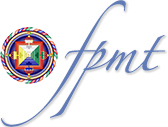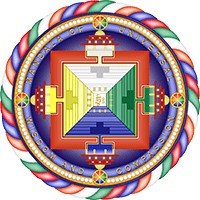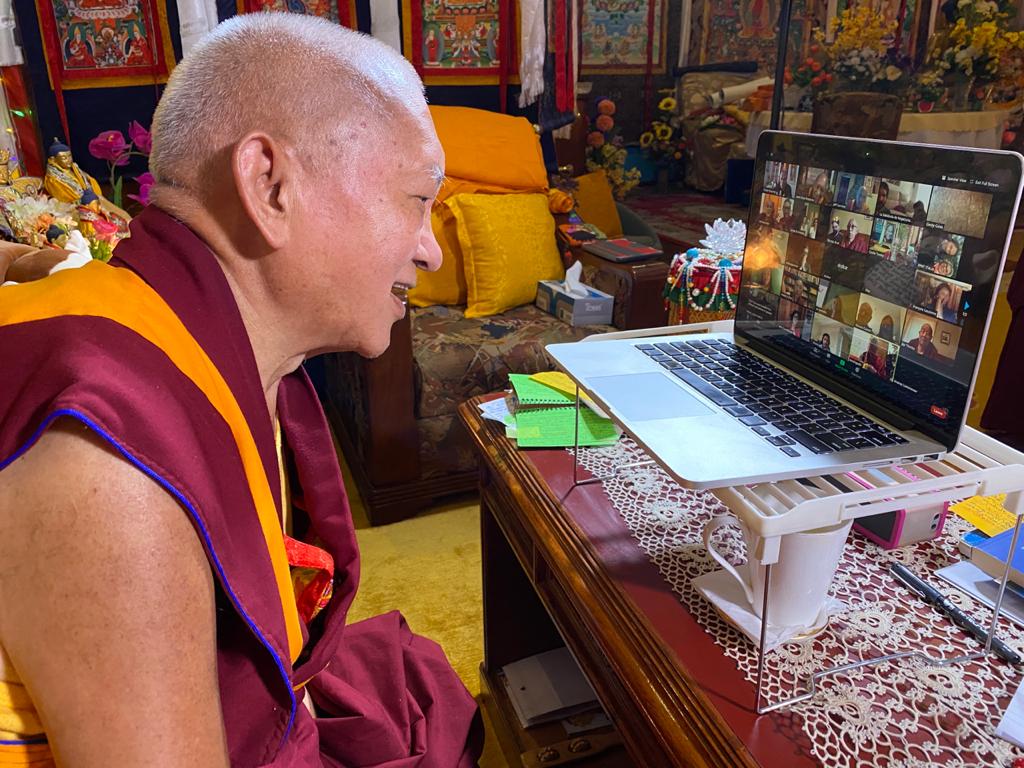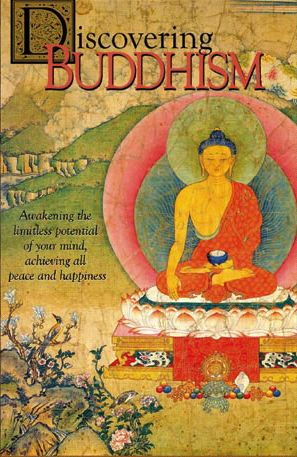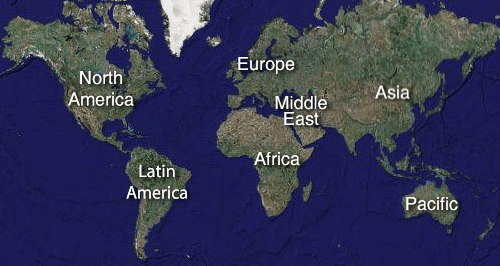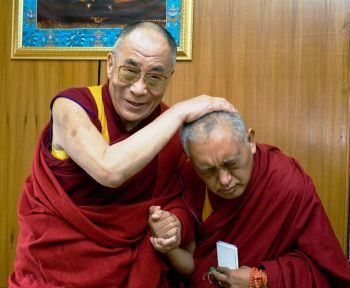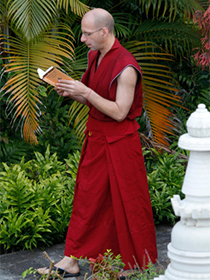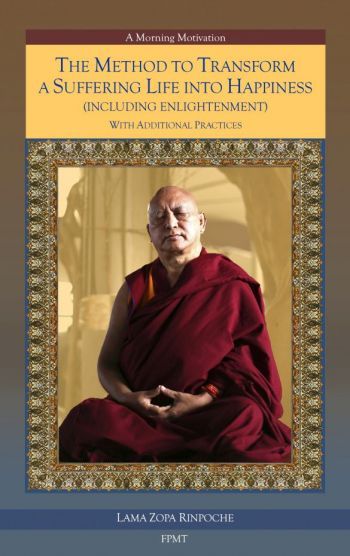- Home
- FPMT Homepage
Foundation for the Preservation of the Mahayana Tradition
The FPMT is an organization devoted to preserving and spreading Mahayana Buddhism worldwide by creating opportunities to listen, reflect, meditate, practice and actualize the unmistaken teachings of the Buddha and based on that experience spreading the Dharma to sentient beings. We provide integrated education through which people’s minds and hearts can be transformed into their highest potential for the benefit of others, inspired by an attitude of universal responsibility and service. We are committed to creating harmonious environments and helping all beings develop their full potential of infinite wisdom and compassion. Our organization is based on the Buddhist tradition of Lama Tsongkhapa of Tibet as taught to us by our founders Lama Thubten Yeshe and Lama Thubten Zopa Rinpoche.
- Willkommen
Die Stiftung zur Erhaltung der Mahayana Tradition (FPMT) ist eine Organisation, die sich weltweit für die Erhaltung und Verbreitung des Mahayana-Buddhismus einsetzt, indem sie Möglichkeiten schafft, den makellosen Lehren des Buddha zuzuhören, über sie zur reflektieren und zu meditieren und auf der Grundlage dieser Erfahrung das Dharma unter den Lebewesen zu verbreiten.
Wir bieten integrierte Schulungswege an, durch denen der Geist und das Herz der Menschen in ihr höchstes Potential verwandelt werden zum Wohl der anderen – inspiriert durch eine Haltung der universellen Verantwortung und dem Wunsch zu dienen. Wir haben uns verpflichtet, harmonische Umgebungen zu schaffen und allen Wesen zu helfen, ihr volles Potenzial unendlicher Weisheit und grenzenlosen Mitgefühls zu verwirklichen.
Unsere Organisation basiert auf der buddhistischen Tradition von Lama Tsongkhapa von Tibet, so wie sie uns von unseren Gründern Lama Thubten Yeshe und Lama Thubten Zopa Rinpoche gelehrt wird.
- Bienvenidos
La Fundación para la preservación de la tradición Mahayana (FPMT) es una organización que se dedica a preservar y difundir el budismo Mahayana en todo el mundo, creando oportunidades para escuchar, reflexionar, meditar, practicar y actualizar las enseñanzas inconfundibles de Buda y en base a esa experiencia difundir el Dharma a los seres.
Proporcionamos una educación integrada a través de la cual las mentes y los corazones de las personas se pueden transformar en su mayor potencial para el beneficio de los demás, inspirados por una actitud de responsabilidad y servicio universales. Estamos comprometidos a crear ambientes armoniosos y ayudar a todos los seres a desarrollar todo su potencial de infinita sabiduría y compasión.
Nuestra organización se basa en la tradición budista de Lama Tsongkhapa del Tíbet como nos lo enseñaron nuestros fundadores Lama Thubten Yeshe y Lama Zopa Rinpoche.
A continuación puede ver una lista de los centros y sus páginas web en su lengua preferida.
- Bienvenue
L’organisation de la FPMT a pour vocation la préservation et la diffusion du bouddhisme du mahayana dans le monde entier. Elle offre l’opportunité d’écouter, de réfléchir, de méditer, de pratiquer et de réaliser les enseignements excellents du Bouddha, pour ensuite transmettre le Dharma à tous les êtres. Nous proposons une formation intégrée grâce à laquelle le cœur et l’esprit de chacun peuvent accomplir leur potentiel le plus élevé pour le bien d’autrui, inspirés par le sens du service et une responsabilité universelle. Nous nous engageons à créer un environnement harmonieux et à aider tous les êtres à épanouir leur potentiel illimité de compassion et de sagesse. Notre organisation s’appuie sur la tradition guéloukpa de Lama Tsongkhapa du Tibet, telle qu’elle a été enseignée par nos fondateurs Lama Thoubtèn Yéshé et Lama Zopa Rinpoché.
Visitez le site de notre Editions Mahayana pour les traductions, conseils et nouvelles du Bureau international en français.
Voici une liste de centres et de leurs sites dans votre langue préférée
- Benvenuto
L’FPMT è un organizzazione il cui scopo è preservare e diffondere il Buddhismo Mahayana nel mondo, creando occasioni di ascolto, riflessione, meditazione e pratica dei perfetti insegnamenti del Buddha, al fine di attualizzare e diffondere il Dharma fra tutti gli esseri senzienti.
Offriamo un’educazione integrata, che può trasformare la mente e i cuori delle persone nel loro massimo potenziale, per il beneficio di tutti gli esseri, ispirati da un’attitudine di responsabilità universale e di servizio.
Il nostro obiettivo è quello di creare contesti armoniosi e aiutare tutti gli esseri a sviluppare in modo completo le proprie potenzialità di infinita saggezza e compassione.
La nostra organizzazione si basa sulla tradizione buddhista di Lama Tsongkhapa del Tibet, così come ci è stata insegnata dai nostri fondatori Lama Thubten Yeshe e Lama Zopa Rinpoche.
Di seguito potete trovare un elenco dei centri e dei loro siti nella lingua da voi prescelta.
- 欢迎 / 歡迎
简体中文
“护持大乘法脉基金会”( 英文简称:FPMT。全名:Foundation for the Preservation of the Mahayana Tradition) 是一个致力于护持和弘扬大乘佛法的国际佛教组织。我们提供听闻,思维,禅修,修行和实证佛陀无误教法的机会,以便让一切众生都能够享受佛法的指引和滋润。
我们全力创造和谐融洽的环境, 为人们提供解行并重的完整佛法教育,以便启发内在的环宇悲心及责任心,并开发内心所蕴藏的巨大潜能 — 无限的智慧与悲心 — 以便利益和服务一切有情。
FPMT的创办人是图腾耶喜喇嘛和喇嘛梭巴仁波切。我们所修习的是由两位上师所教导的,西藏喀巴大师的佛法传承。
繁體中文
護持大乘法脈基金會”( 英文簡稱:FPMT。全名:Found
ation for the Preservation of the Mahayana Tradition ) 是一個致力於護持和弘揚大乘佛法的國際佛教組織。我們提供聽聞, 思維,禪修,修行和實證佛陀無誤教法的機會,以便讓一切眾生都能 夠享受佛法的指引和滋潤。 我們全力創造和諧融洽的環境,
為人們提供解行並重的完整佛法教育,以便啟發內在的環宇悲心及責 任心,並開發內心所蘊藏的巨大潛能 — 無限的智慧與悲心 – – 以便利益和服務一切有情。 FPMT的創辦人是圖騰耶喜喇嘛和喇嘛梭巴仁波切。
我們所修習的是由兩位上師所教導的,西藏喀巴大師的佛法傳承。 察看道场信息:
- FPMT Homepage
- News/Media
-
- Study & Practice
-
-
- About FPMT Education Services
- Latest News
- Programs
- New to Buddhism?
- Buddhist Mind Science: Activating Your Potential
- Heart Advice for Death and Dying
- Discovering Buddhism
- Living in the Path
- Exploring Buddhism
- FPMT Basic Program
- FPMT Masters Program
- FPMT In-Depth Meditation Training
- Maitripa College
- Lotsawa Rinchen Zangpo Translator Program
- Universal Education for Compassion & Wisdom
- Online Learning Center
-
- Prayers & Practice Materials
- Overview of Prayers & Practices
- Full Catalogue of Prayers & Practice Materials
- Explore Popular Topics
- Benefiting Animals
- Chenrezig Resources
- Death & Dying Resources
- Lama Chopa (Guru Puja)
- Lama Zopa Rinpoche: Compendium of Precious Instructions
- Lama Zopa Rinpoche: Life Practice Advice
- Lama Zopa Rinpoche Practice Series
- Lamrim Resources
- Mantras
- Prayer Book Updates
- Purification Practices
- Sutras
- Thought Transformation (Lojong)
- Audio Materials
- Dharma Dates - Tibetan Calendar
- Translation Services
- Publishing Services
- Ways to Offer Support
- Prayers & Practice Materials
-
- Teachings and Advice
- Find Teachings and Advice
- Lama Zopa Rinpoche Advice Page
- Lama Zopa Rinpoche: Compendium of Precious Instructions
- Lama Zopa Rinpoche Video Teachings
- ༧སྐྱབས་རྗེ་བཟོད་པ་རིན་པོ་ཆེ་མཆོག་ནས་སྩལ་བའི་བཀའ་སློབ་བརྙན་འཕྲིན།
- Podcasts
- Lama Yeshe Wisdom Archive
- Buddhism FAQ
- Dharma for Young People
- Resources on Holy Objects
- Teachings and Advice
-
-
*If a menu item has a submenu clicking once will expand the menu clicking twice will open the page.
-
-
- Centers
-
- Teachers
-
- Projects
-
-
-
-
*If a menu item has a submenu clicking once will expand the menu clicking twice will open the page.
-
-
- FPMT
-
-
-
-
-
I want to say without hesitation that the purpose of our life is happiness.
His Holiness the Dalai Lama
-
-
-
- Shop
-
-
-
The Foundation Store is FPMT’s online shop and features a vast selection of Buddhist study and practice materials written or recommended by our lineage gurus. These items include homestudy programs, prayers and practices in PDF or eBook format, materials for children, and other resources to support practitioners.
Items displayed in the shop are made available for Dharma practice and educational purposes, and never for the purpose of profiting from their sale. Please read FPMT Foundation Store Policy Regarding Dharma Items for more information.
-
-
Lama Zopa Rinpoche News
4
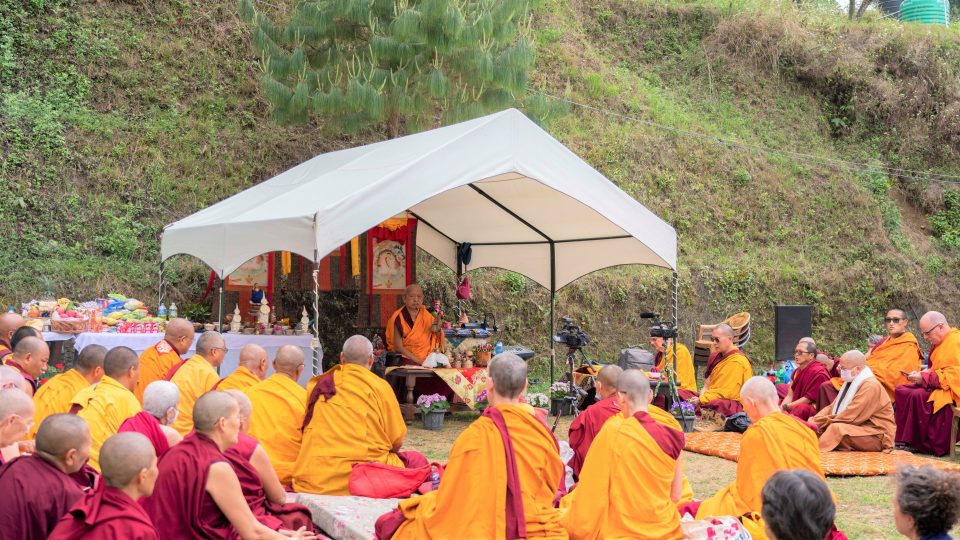
Lama Zopa Rinpoche offering a Milarepa initiation in Shavapuri Village, Nepal, April 6, 2022. Photo by Ven. Lobsang Sherab.
The great yogi Milarepa (1040-1123) is one of the most revered figures in Tibetan history and among all sects of Tibetan Buddhism. Milarepa’s guru was the famous translator, Marpa (1012-1097), himself the main disciple of Naropa (1016-1100).
Marpa taught Milarepa through a variety of seemingly futile tasks. One famous story records that Milarepa was instructed to build a large tower out of nearby boulders. Once the tower was complete, he was asked to tear it down and rebuild it in another location. Once this task was complete, he again was instructed to tear it down and rebuild. Other stories account for Marpa’s teachings on enduring and persevering through hardships. Milarepa’s devotion to his guru enabled him to progress on the path quickly.
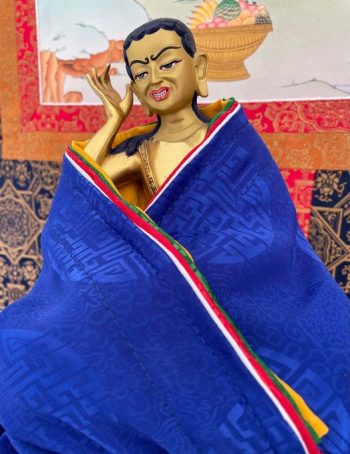
Statue of Milarepa that was brought to the initiation by Ven. Drachom. Photo by Ven. Sarah Thresher.
On April 6, Lama Zopa Rinpoche offered a Milarepa initiation and teachings to a small group of senior Kopan monks, senior Khachoe Ghakyil Ling nuns, Western sangha, and some lay students. The occasion of this initiation was for Ven. Tenzin Drachom (Fred Cheong), a long-time Singaporean student who required the initiation prior to engaging in personal retreat. The initiation was offered in Shivapuri Village, an eco-resort and conservation farm a short distance northwest of Kopan Monastery. The resort is located within the beautiful hills of Shivapuri Nagarjun National Park, which is a protected area for a diversity of wild animals.
Rinpoche arrived at Shivapuri Village at 11 a.m. for the initiation preparation while the attendees had lunch, kindly sponsored by Ven. Drachom. The teachings started around 3 p.m. with Rinpoche offering profound commentary on “Milarepa’s Hymn,” including the advice that the way to really enjoy happiness in this life is by giving up desire.
According to Ven. Thubten Khadro, who was in attendance, “Rinpoche also taught on the benefits of taking this initiation, which includes being reborn as a disciple of Milarepa and receiving direct teachings from him, and by virtue of reciting Milarepa’s mantra seven times daily, one won’t be reborn in the lower realms. Rinpoche also read ‘Calling the Guru from Afar,’ a prayer composed by Jamyang Chokyi Lodro, as a motivation for the initiation. The initiation itself was short and concluded with a blissful tsog that included vegan cakes!”
We invite you to watch the teaching that Lama Zopa Rinpoche offered prior to the Milarepa initiation. A full transcript of this teaching is available.
Lama Zopa Rinpoche is the spiritual director of the Foundation for the Preservation of Mahayana Tradition (FPMT), a Tibetan Buddhist organization dedicated to the transmission of the Mahayana Buddhist tradition and values worldwide through teaching, meditation and community service.
14
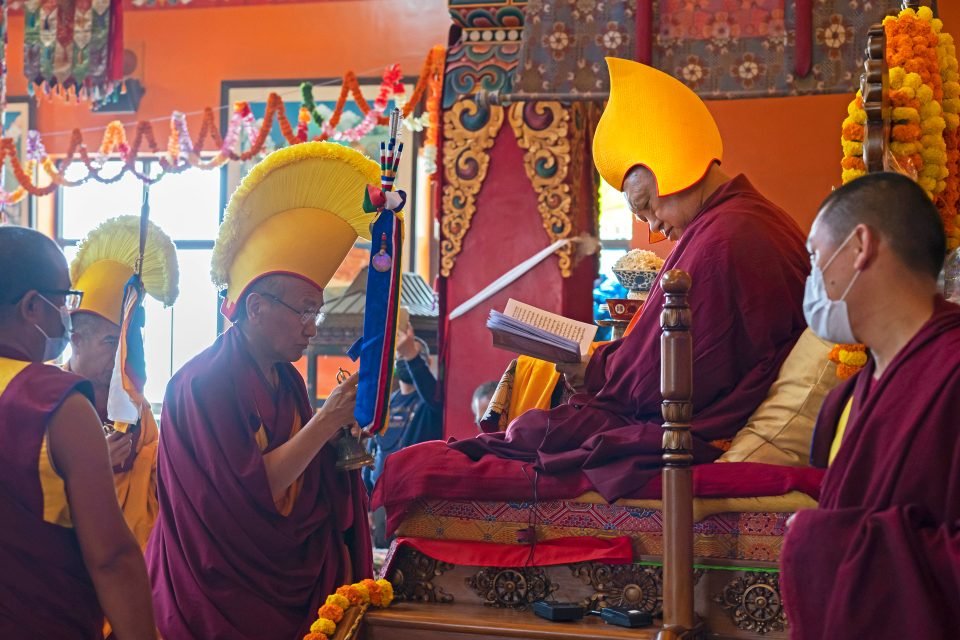
Lama Zopa Rinpoche during the long life puja offered to him, Kopan Monastery, Nepal, March 2022. Photo by Ven. Lobsang Sherab.
Since our last update, Lama Zopa Rinpoche has remained in Nepal, engaging in a variety of auspicious activities, including doing a personal retreat. Rinpoche also was offered a long life puja, met with important people and lamas, offered prayers and pujas during the Fifteen Days of Miracles, created merit in relation to holy objects, attended the inauguration of a new dialysis clinic, and offered two new teachings. We invite you to read more about these activities below and to join us in rejoicing in the compassionate service Rinpoche offers every day, inspiring us all to live a full and beneficial life.
Long Life Puja
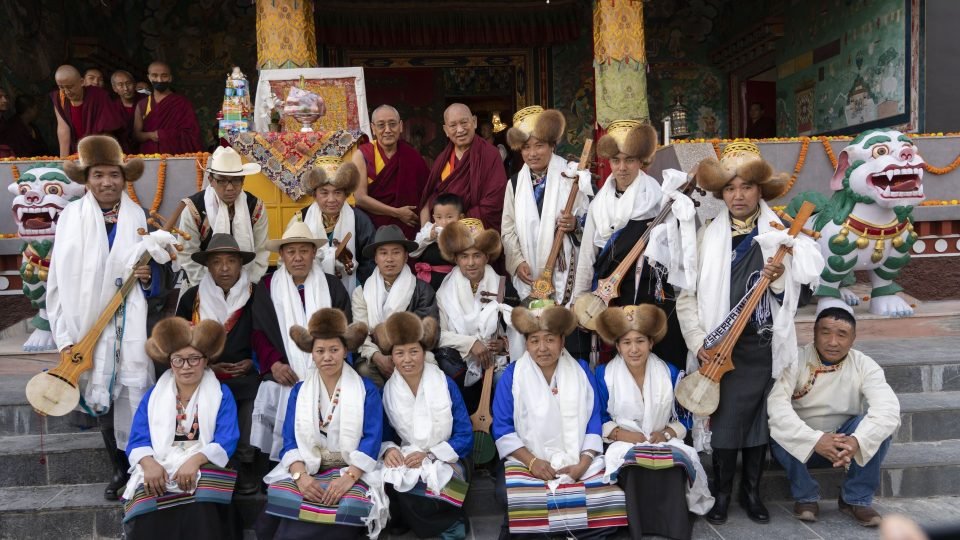
Lama Zopa Rinpoche with the Sherpa dancers following the long life puja offered to Rinpoche at Kopan Monastery, Nepal, March 11, 2022. Photo by Ven. Lobsang Sherab.
A long life puja was offered on behalf of the entire FPMT organization to Lama Zopa Rinpoche at Kopan Monastery, Nepal, on March 11. The puja was a joyful occasion that included lama and Sherpa dances in the courtyard and a picnic in the stupa garden. There were several days of preparatory practices done by Kopan monks and nuns leading up to the long life puja. On the day of the puja, Kopan Abbot Khen Rinpoche Geshe Chonyi, Yangsi Rinpoche, Losang Namgyal Rinpoche, Rigsel Rinpoche, Kopan monks and nuns, and many others were in attendance.
Teachings and Advice
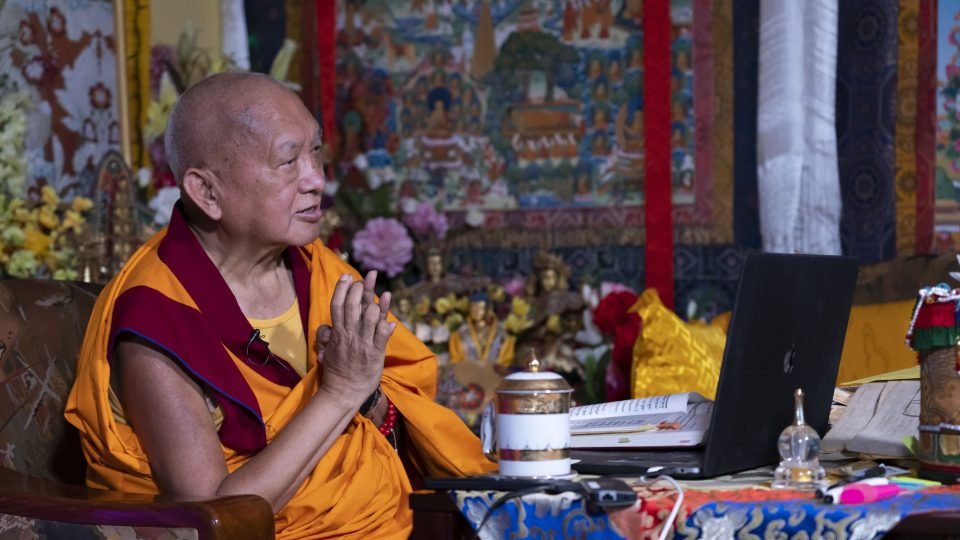
From Kopan Monastery, Rinpoche offering a talk to Sangha at the beginning of a three-month Vinaya course helded at Istituto Lama Tzong Khapa, Italy, March 2022. Photo by Ven. Lobsang Sherab.
On February 25, Rinpoche offered timely advice regarding practices to reduce the war in Ukraine and to help stop violence and suffering. Rinpoche also arranged a number of powerful pujas, such as controlling fire pujas, wrathful fire pujas, and Drugchuma (Sixty-Four Offerings to Kalarupa).
Rinpoche also gave two teachings recorded on video recently, which we’ve shared in blog posts complete with summaries:
- The Western Sangha Are the Real Heroes, a teaching Rinpoche offered at the beginning of a three-month course on the Vinaya being held at Istituto Lama Tzong Khapa.
- Why Buddhism Is So Important, a teaching Rinpoche offered to the Vajrasattva retreatants at Kopan Monastery.
Meeting with Important Individuals
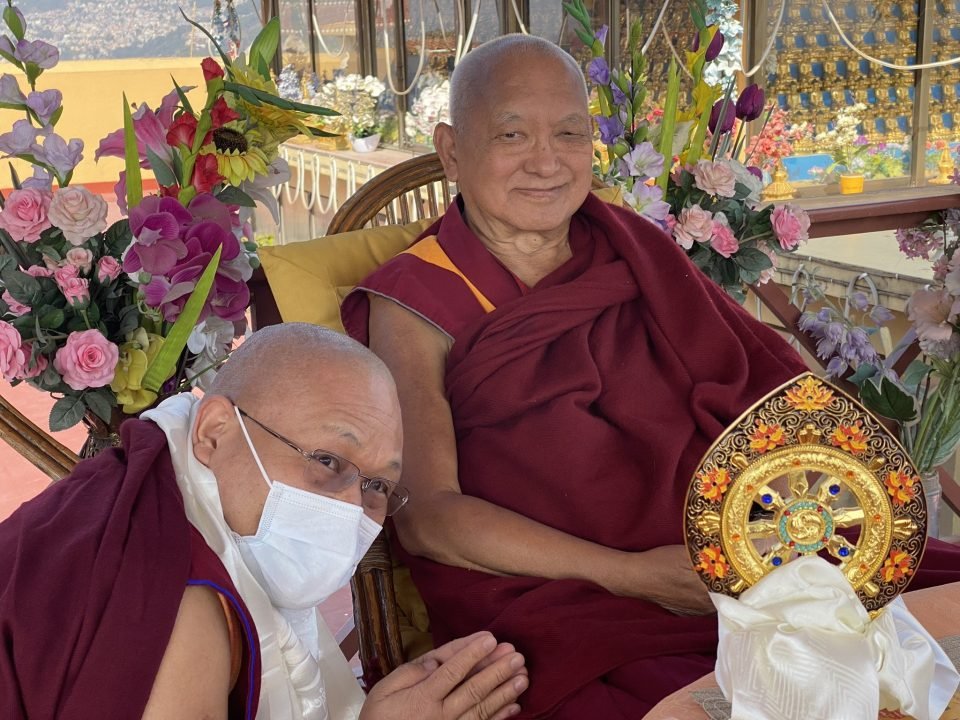
Lama Zopa Rinpoche meeting with Geshe Jampa Tsundue, resident teacher of Lobsang Dragpa Centre in Malaysia, at Kopan Monastery, January 2022. Photo by Ven. Roger Kunsang.
In early January, Rinpoche invited Khadro-la (Rangjung Neljorma Khadro Namsel Drönme) for lunch at a nice resort outside of Kathmandu with breathtaking panoramic views of snow-capped mountains. While there, Rinpoche and Khadro-la also offered prayers and pujas. Later in January at Kopan Monastery, Rinpoche met with Geshe Jampa Tsundue, resident teacher of Lobsang Dragpa Centre, Malaysia.
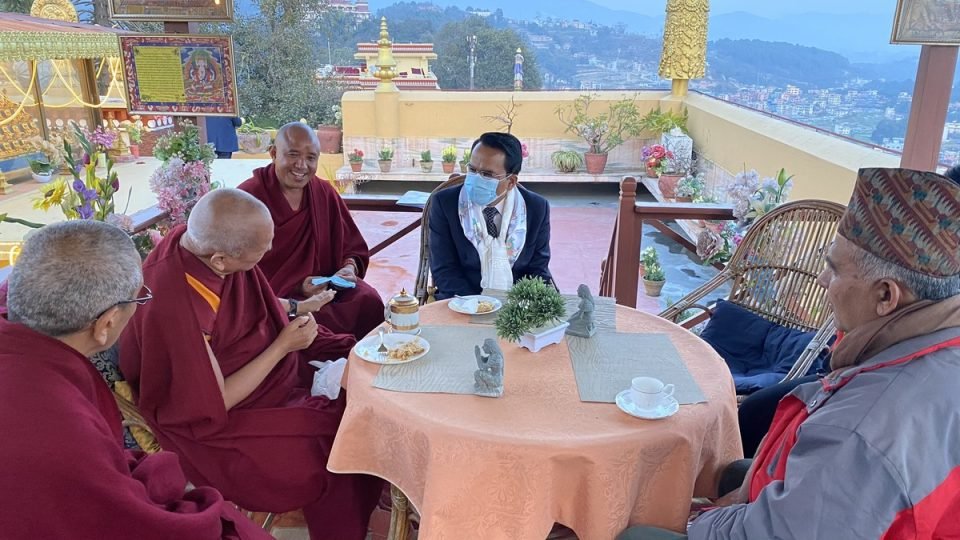
Khen Rinpoche Geshe Chonyi, Lama Zopa Rinpoche, Phuba Chhbe Sherpa (Bikkhu Thubten Jikdol), Chairman of the National Planning Commission of the Ministry of Education, and Dr. Biswo Nath Poudel, Vice Chairman, discussing education topics during a visit to Kopan Monastery, Nepal, February 23, 2022. Photo by Ven. Roger Kunsang.
Rinpoche met the Chairman and Vice Chairman of the National Planning Commission of the Ministry of Education in February. They spoke about many subjects, such as the Mount Everest School at Kopan Monastery, education within monasteries, Dharma education, as well as secular education focusing on compassion and kindness.
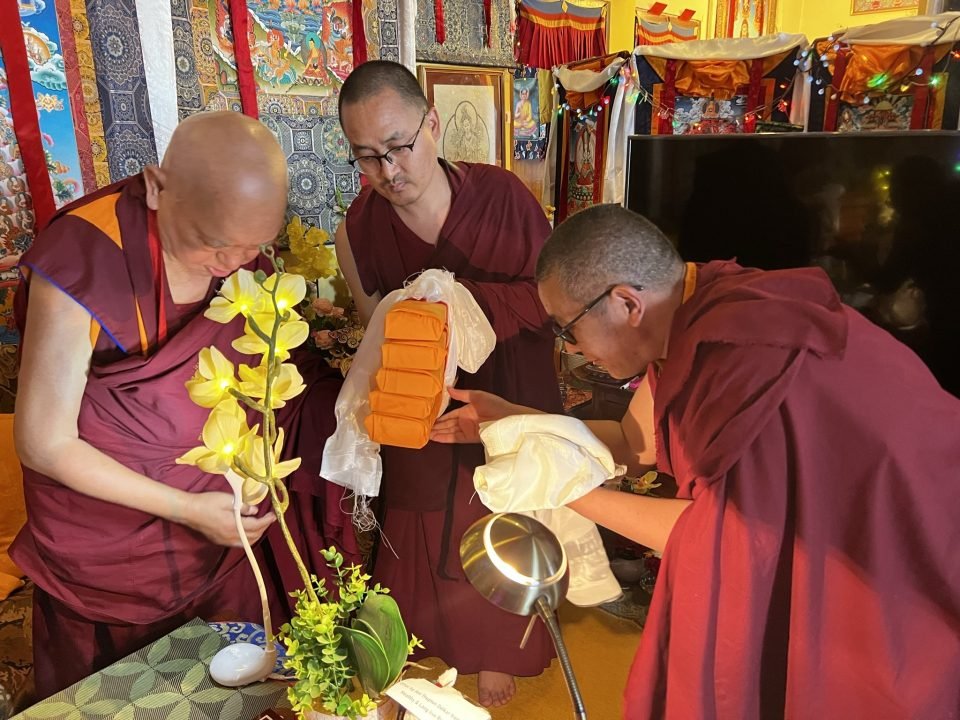
Lama Zopa Rinpoche with Lama Ngawang Chokyab at Kopan Monastery, Nepal, March 13, 2022. Photo by Ven. Roger Kunsang.
In March, Rinpoche met with Lama Ngawang Chokyab, a Nyingma lama and disciple of Trulshik Rinpoche, at Kopan Monastery. Rinpoche also met with Serkong Dorje Chang at his monastery in Swayambhunath.
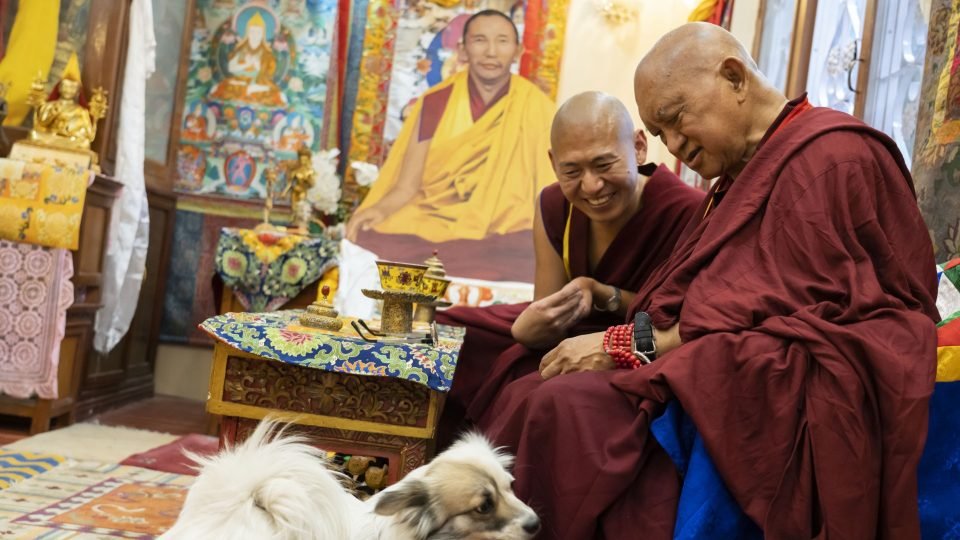
Lama Zopa Rinpoche meeting with Serkong Dorje Chang at his monastery in Swayumbhunath, Nepal, March 13, 2022. Photo by Ven. Lobsang Sherab.
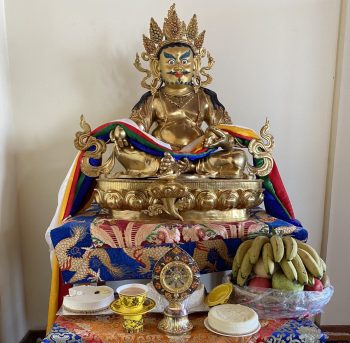
New 3.5-foot (1-meter) tall Dzambhala statue being welcomed to Kopan Monastery.
Holy Objects
Rinpoche greeted a new 3.5-foot (1-meter) tall Dzambhala statue, which arrived at Kopan in January. Rinpoche personally welcomed the statue with prostrations, a five-colored khata offering, a mandala offering, and tsog. Rinpoche wrote a special letter to Dzambhala with prayers and requests for the organization and all beings, and offered this letter of requests to Dzambhala.
Rinpoche made trips to Swayambhunath and Boudha stupas, offering teachings, prayers, and khatas with others.
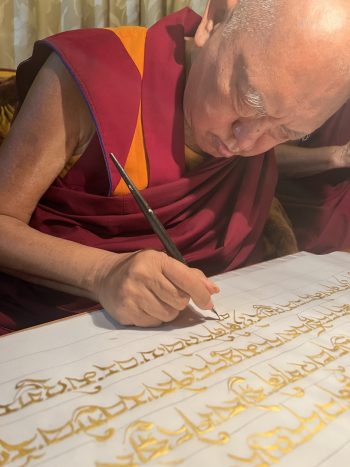
Lama Zopa Rinpoche writing out the Prajnaparamita Sutra, Kopan Monastery, Nepal, March 2022. Photo by Ven. Roger Kunsang.
Rinpoche continued to write out the 8,000 verse Prajnaparamita Sutra in pure gold. Under Rinpoche’s guidance several students have been writing out the Prajnaparamita on archival quality rainbow paper, including Ven. Tsering, who is now based at Kopan Monastery and is writing out volumes from the 12,000 verse Prajnaparamita, as well as Jane Seidlitz in United States and Ven. Nina at Khachoe Ghakyil Ling Nunnery in Nepal.
Offering Prayers and Pujas
Rinpoche offered sur practice at night at Kopan Monastery in front of the 1,000 Buddha altar on the roof of Kopan’s main gompa. Rinpoche has explained that by offering sur practice, one will have success and be born in a pure land, and whatever work one is doing will be successful and not have obstacles.
Most Secret Hayagriva tsog kong was offered at Kopan for Rinpoche’s long life and for the success of the entire organization on March 2. Rinpoche, Khen Rinpoche Geshe Chonyi, and Kopan monks offered Palden Lhamo puja to start the new year auspiciously on March 3. Lama Chopa was also offered at Kopan Monastery on Losar. On the third day of Losar, Rinpoche led incense puja with Khen Rinpoche Geshe Chonyi and senior Kopan monks on Kopan Hill, where they made strong prayers for all beings and to remove obstacles and bring success.
On April 2, Rinpoche attended a long life puja for Khadro-la.
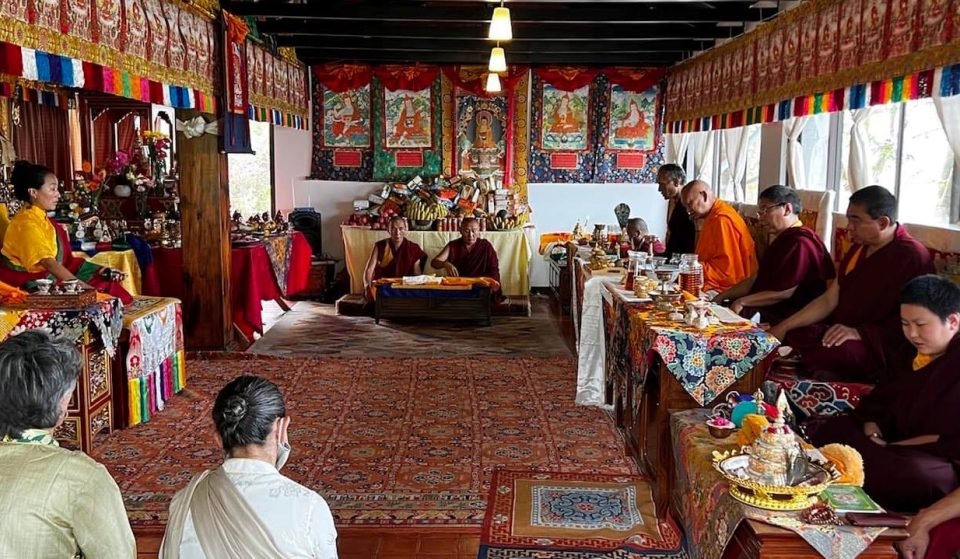
Long life puja offered to Khadro-la (Rangjung Neljorma Khadro Namsel Drönme), Kathmandu, Nepal, April 2, 2022. Photo by Ven. Roger Kunsang.
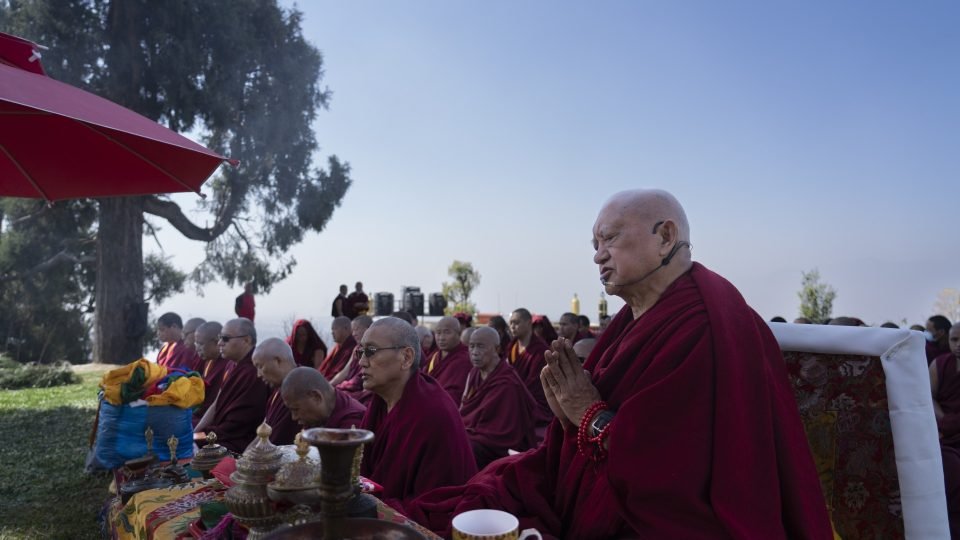
Lama Zopa Rinpoche leading an incense puja on Kopan Hill with Khen Rinpoche Geshe Chonyi and monks of Kopan Monastery, Losar, March 3, 2022. Photo by Ven. Lobsang Sherab.
Maya Daya Clinic
Maya Daya Clinic, established in 1992 at the foot of Kopan Hill, is one way Kopan Monastery has been actively serving the local community. At the time it was created, there was very little medical care in the area, with doctors and pharmacies only accessible in Boudhanath, a forty-five minute walk away. The aim of the clinic was to provide basic healthcare for the local population, with a doctor and nurse available three days a week and regular access to medical supplies at the clinic’s pharmacy. In the years since then, the clinic has benefited thousands of local patients as well as the monks and nuns of Kopan and of other monasteries.
With the need for basic medical care in the local area now well covered by other clinics and pharmacies, Maya Daya Clinic, in cooperation with Karuna Hospital, is taking the next step in its development. As part of an expansion of Karuna Hospital, the clinic will be serving the local community by providing dialysis to those with chronic kidney disease in a comfortable and modern environment. This is an incredible achievement for Kopan Monastery to be able to offer support to the local community in this way. Through the leadership of Ven. Sangye Tenzin, government support has also been obtained for this clinic, which is desperately needed by the local population who will be able to receive dialysis for free.
Lama Zopa Rinpoche attended the inauguration of this clinic on March 5 with Khen Rinpoche Geshe Chonyi. Rinpoche offered a statue of Buddha for the front of Karuna Hospital and also designed the beautiful image of Shakyamuni Buddha with mantras that you can see below in the photo. Please read more about this amazing project.

Lama Zopa Rinpoche and Khen Rinpoche Geshe Chonyi attending the inauguration of the Maya Daya Clinic at Karuna Hospital on March 5, 2022. Rinpoche designed the image of Shakyamuni Buddha with mantras in the background. Photo by Ven. Lobsang Sherab.
We invite you to see more photos of Rinpoche in our January–March 2022 photo album:
https://fpmt.org/teachers/zopa/gallery/nepal-january-march-2022/
Lama Zopa Rinpoche is the spiritual director of the Foundation for the Preservation of Mahayana Tradition (FPMT), a Tibetan Buddhist organization dedicated to the transmission of the Mahayana Buddhist tradition and values worldwide through teaching, meditation and community service.
- Tagged: lama zopa rinpoche, lama zopa rinpoche long life puja, long life puja, long life puja for lama zopa rinpoche
9
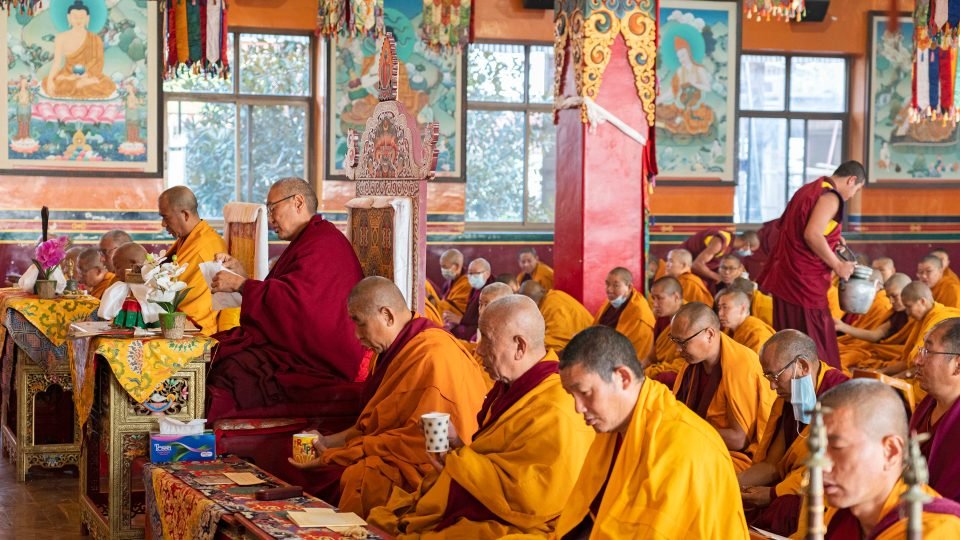
Sangha from Kopan Monastery and Khachoe Ghakyil Nunnery doing prayers and practices in preparation for the long life puja for Lama Zopa Rinpoche, Kopan Monastery, Nepal, March 2022. Photo by Ven. Lobsang Sherab.
A White Tara long life puja will be offered to FPMT Spiritual Director Lama Zopa Rinpoche on March 11, 2022, at Kopan Monastery in Nepal. Currently, the monks and nuns from Kopan Monastery and Khachoe Ghakyil Nunnery are doing seven days of practice in preparation for this special long life puja.
A long life puja offered to one’s teacher is a powerful opportunity to show devotion. The heartfelt prayers and praises along with the procession of symbolic offerings made to a spiritual guide create extensive merit. In addition, one is able to purify the mistakes that occur in relation to a teacher and to create the causes and conditions to continue to receive benefit from that teacher for a very long time. And, as Lama Zopa Rinpoche regularly mentions, offering long life pujas is a cause for one’s own long life.
We are pleased to share a short video of the long life puja preparations at Kopan Monastery:
The long life puja on March 11 will be offered to Lama Zopa Rinpoche on behalf of the entire FPMT organization. Our prayers have tremendous power, and we invite you to join us by rejoicing in the puja being offered, generating your own prayers for Rinpoche’s health and long life, or making an offering toward the expenses associated with the pujas and practices for Rinpoche’s health and long life.
Lama Zopa Rinpoche is the spiritual director of the Foundation for the Preservation of Mahayana Tradition (FPMT), a Tibetan Buddhist organization dedicated to the transmission of the Mahayana Buddhist tradition and values worldwide through teaching, meditation and community service.
Visit our Long Life Puja Fund page to learn more about the purpose of long life pujas and opportunities to offer support for them.
For additional recent advice on mantra recitations to do for Lama Zopa Rinpoche, His Holiness the Dalai Lama, and the entire FPMT organization see:
fpmt.org/lama-zopa-rinpoche-news-and-advice/mantra-recitations-for-his-holiness-the-dalai-lama-lama-zopa-rinpoche-and-fpmt
- Tagged: lama zopa rinpoche long life puja, long life puja, long life puja for lama zopa rinpoche, long life puja fund, video short
4
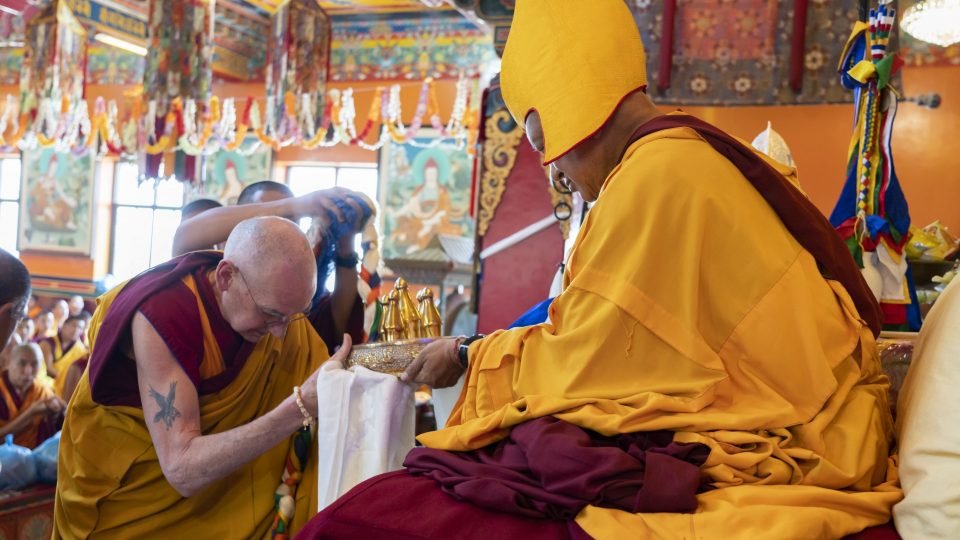
Ven. Roger Kunsang offering a mandala to Lama Zopa Rinpoche during the April 19, 2021 long life puja at Kopan Monastery
Every year Ven. Roger Kunsang, on behalf of the FPMT organization, checks with Lama Zopa Rinpoche’s gurus and/or Rangjung Neljorma Khadro Namsel Drönme (Khadro-la), to determine what practices should be done to help create the conditions for Lama Zopa Rinpoche to have a long life and good health for the coming year.
The first offering to Rinpoche arranged this year will be a White Tara long life puja on March 11, 2022, at Kopan Monastery. This special long life puja will involve seven days of preparation led by Khadro-la with the Kopan monks. At a later date there will be a Most Secret Hayagriva tsog kong and a Guru Rinpoche bum tsog also offered according to the advice received.
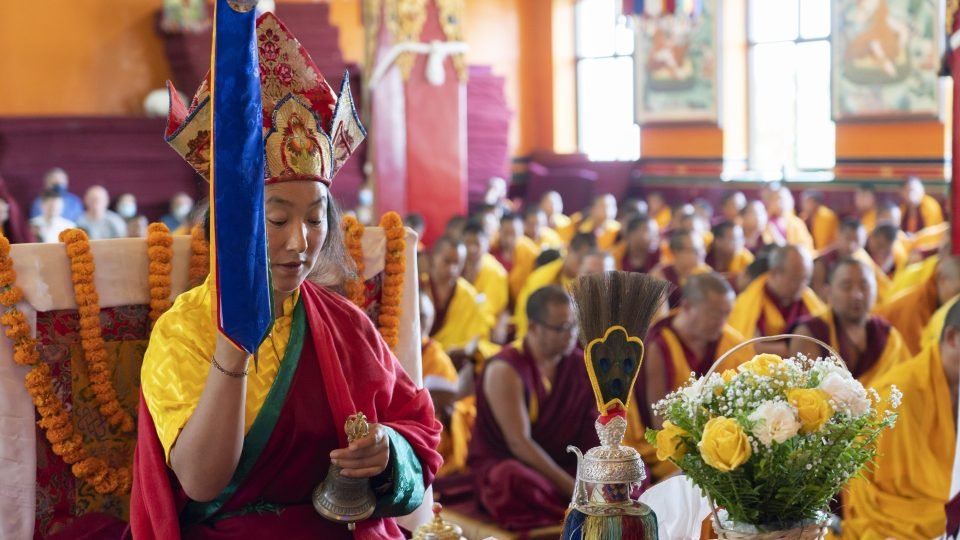
Khadro-la making an offering during a long life puja to Lama Zopa Rinpoche, April 2021. Photo by Ven. Lobsang Sherab.
Our prayers have tremendous power and we invite you to join us by rejoicing in the puja being offered, generating your own prayers for Rinpoche’s health and long life, or making an offering toward the expenses associated with the pujas and practices for Rinpoche’s health and long life.
For additional recent advice from Khadro-la on mantra recitations to do for Lama Zopa Rinpoche, His Holiness the Dalai Lama, and the entire FPMT organization see: fpmt.org/lama-zopa-rinpoche-news-and-advice/mantra-recitations-for-his-holiness-the-dalai-lama-lama-zopa-rinpoche-and-fpmt
Lama Zopa Rinpoche is the spiritual director of the Foundation for the Preservation of Mahayana Tradition (FPMT), a Tibetan Buddhist organization dedicated to the transmission of the Mahayana Buddhist tradition and values worldwide through teaching, meditation and community service.
The Long Life Puja Fund always contributes to long life pujas offered to Lama Zopa Rinpoche. You can also learn about the many Charitable Projects of FPMT and discover how the various funds and projects are benefiting others.
1
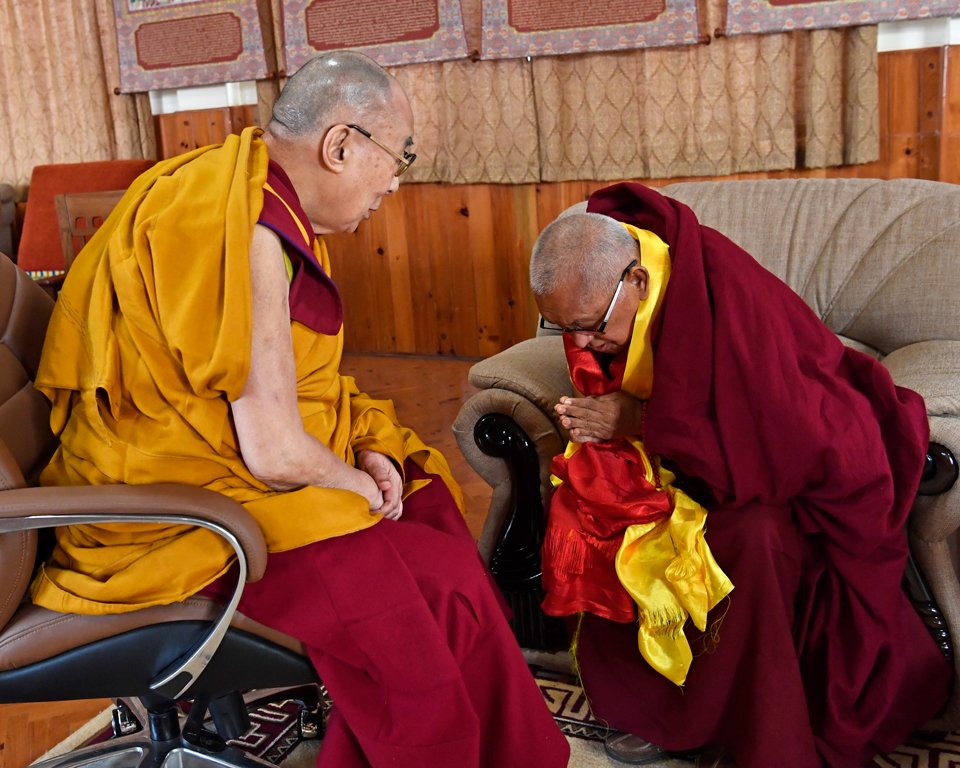
His Holiness the Dalai Lama meeting with Lama Zopa Rinpoche, Bodhgaya, India, January 2020. Photo courtesy of the Office of His Holiness the Dalai Lama.
At the beginning of each Tibetan year, Ven. Roger Kunsang requests advice for Lama Zopa Rinpoche’s health and the success of the FPMT organization. This year Rangjung Neljorma Khadro Namsel Dronme (Khadro-la) has advised that it would be extremely beneficial if FPMT students can recite Chenrezig and White Tara mantras for His Holiness the Dalai Lama and Lama Zopa Rinpoche’s health, for the fulfilment of all their wishes, and for the benefit of all in the FPMT organization.
The request is to recite these mantras during the most meritorious period starting with Losar (March 3), and up to and including the last of the Days of Miracles, Chotrul Duchen, on March 18. Please dedicate using the FPMT dedication prayers (in the FPMT Essential Prayer Book and Complete Dedication Prayer Book), including the long life prayer for His Holiness the Dalai Lama.
Whether you are doing them individually or as part of a group at your local center, project, or service; please keep track of the numbers of mantras you complete. You can send your individual recitation numbers on March 19 to Claire Isitt, and if you are connected to a local FPMT center, please send them your recitation numbers. Ven. Roger will then offer that accumulation of meritorious activity to Lama Zopa Rinpoche on behalf of us all.
- Chenrezig mantra:
OM MANI PADME HŪM (link to a short practice from Education Services)
- White Tara mantra:
OM TĀRE TUTTĀRE TURE MAMA ĀYUR PUṆYE JÑĀNA PUSHTIM KURUYE SVĀHĀ (link to a short meditation from Education Services)
These practices are in addition to the long life puja being offered to Lama Zopa Rinpoche on March 11 (with seven days of preparatory pujas being offered). We will send more details and a reminder about this auspicious long life puja at the end of the week.
His Holiness the 14th the Dalai Lama, Tenzin Gyatso, is the spiritual leader of the Tibetan people.
Lama Zopa Rinpoche is the spiritual director of the Foundation for the Preservation of Mahayana Tradition (FPMT), a Tibetan Buddhist organization dedicated to the transmission of the Mahayana Buddhist tradition and values worldwide through teaching, meditation and community service.
25
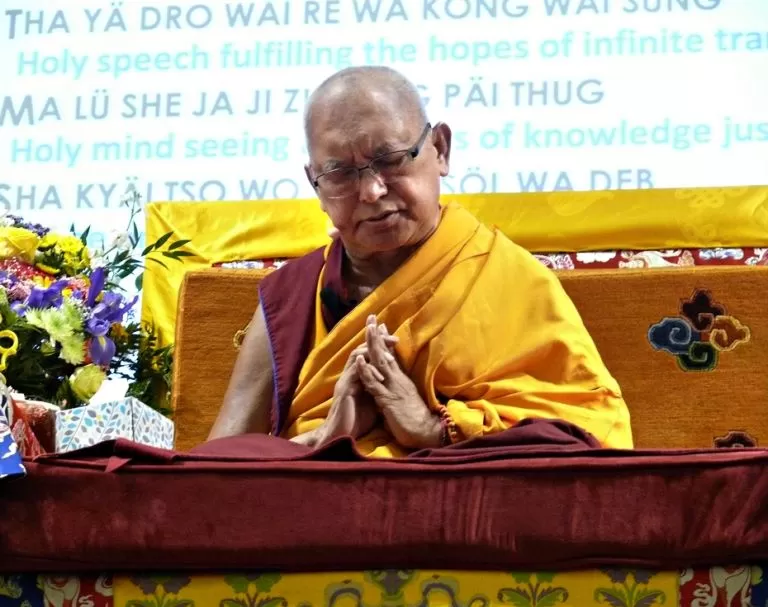
Lama Zopa Rinpoche at Light of the Path, Black Mountain, North Carolina, US, September 2017. Photo by Kalleen Mortensen.
Lama Zopa Rinpoche led the first Light of the Path retreat in 2009 in North Carolina, US, hosted by Kadampa Center. The last retreat was in 2017 and the next highly anticipated retreat is this year, August 14 – 28 2022!
Kadampa Center shares this important update:
The Light of the Path Retreat is returning this year (August 14-28) , in a new model that we hope will allow students all over the world to hear Lama Zopa Rinpoche’s precious teachings together.
We have requested Rinpoche to teach each day, for approximately two hours, beginning at around 8 p.m. Nepal time. You will be able to find Rinpoche’s teaching time for your local time zone.
We are putting the finishing touches on a hybrid retreat, with both online and in-person opportunities. As we get closer to August, we will share our schedule and offer some suggestions for designing schedules for personal retreat.
We have invited retreat and residential centers from around the world to hold in-person retreats on their home sites, so that retreatants can experience true retreat in person and in community with other students. We are still working out the details with several centers; watch for more news about where to attend the retreat in person!
We also encourage students who are unable to attend in person to take this time off work and do retreat from home, following the teachings, prayers, and practices online. Some students are forming “pods” to rent space and do retreat in person together in small groups.
We expect to open registration in March. Watch for more information as we finalize the details.
We recommend that students prepare for Light of the Path 2022 by reviewing Rinpoche’s teachings in previous Light of the Path retreats.
Please refer to Kadampa Center’s website for registration details in March.
FPMT.org and Mandala Publications brings you news of Lama Zopa Rinpoche and of activities, teachings, and events from 150 FPMT centers, projects, and services around the globe. If you like what you read, consider becoming a Friend of FPMT, which supports our work.
- Tagged: light of the path, light of the path 2022
22
The Power of Mantra
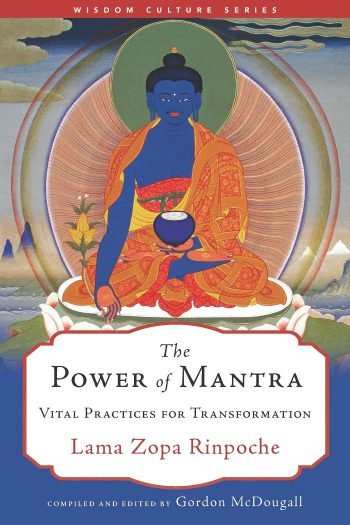
The Sanskrit word mantra (which is ngag in Tibetan) has two syllables: man, which means “mind,” and tra, which means “protect,” so a mantra is something that protects our mind.
The benefits of mantra recitation are vast. There are many stories about terrible diseases such as cancer being cured by mantras, or people or animals being helped to have a peaceful death and a positive rebirth through mantras being recited to them. But the supreme benefit of a mantra is its ability to transform our mind. When we recite a mantra such as Shakyamuni’s mantra, we are recalling the Buddha’s name over and over, helping us increase our closeness and devotion to the Buddha, and devotion is our real protection from suffering. By transforming our mind, it has the power to break negative habits and develop positive ones. As our mind changes, our ability to help others increases, so we are reciting mantras for others as well.
By linking us to the omniscient mind—the wisdom and compassion of the Buddha and all the enlightened beings—reciting a mantra invokes that great power, leading us from nonvirtue to virtue. The Buddha said,
Do not commit any nonvirtuous actions,
perform only perfect virtuous actions,
subdue your mind thoroughly—
this is the teaching of the Buddha.
The whole Buddhist path comes down to these two pieces of advice—to not harm others and to benefit them. In order to do that, we must subdue the mind, which means both collecting merit through doing only virtuous actions and purifying any negative imprints on our mindstream from negative actions we have done in the past.
Reciting a mantra such as OM MANI PADME HUM, the mantra of Chenrezig, is not only the most unbelievable purification—purifying defilements and negative karmas collected from not just this life but from beginningless rebirths—it also collects extensive merits.
In the West, when soccer players win, they throw their arms up in the air and run around. It’s very intense. When I first saw this, I thought they were very angry because of the strong emotion. If they feel that strongly about winning a match, we should feel a billion times more strongly about being able to purify all that negative karma and accumulate all that merit, simply by reciting a mantra.
Westerners have asked me many times to explain how mantras work. This is a question that comes from the Western mind; it’s not asked in Asia, certainly not among the Tibetans, because they have faith. When there is water, what does water do? It makes things wet; that is its nature. Fire has its own nature; its nature is to burn. Everything has its own nature. Mantras too have their own nature; their nature is to transform the mind. Any word we say affects another person’s mind, making them happy or sad or angry or whatever. The power of the mantra comes from the sound, and that sound has the power to transform the mind into one of virtue.
Thinking of mantras as just some Sanskrit sounds to be chanted is an extremely limited view of what they are; they are much more than that. The sound of a mantra has the power to protect us, holding our mind from nonvirtuous thoughts and fostering virtuous ones, thus allowing us to develop toward enlightenment. In the same way that the Dharma in general holds us, protecting us from suffering—Dharma literally means “that which holds”—mantras are mind protection. In A Guide to the Bodhisattva’s Way of Life, the great being Shantideva said,
Therefore, I should focus my mind correctly,
and keep a careful watch over it.
What good will it do to keep many vows,
if one neglects the vow of watching over the mind?
It is vital to remember Shantideva’s advice. If we forget to protect our mind, what is the use of any traditional form of discipline? Even though we may do hundreds of other things, if we leave out this most important practice and leave the mind unprotected, we cannot stop our problems and achieve happiness, especially ultimate happiness. Everything comes from the mind; it is the source of all our suffering and all our happiness, so if we neglect to protect our mind, we cannot close the door to suffering or open it to happiness.
In the West, there are so many external rules: you can’t do this, you can’t do that. Sometimes I think there are too many rules. When we rely on external discipline, we can never solve our problems. The discipline has to come from our own mind. As a Buddhist, we might take certain vows to protect ourselves from committing any of the ten nonvirtuous actions, but unless we protect our mind, those vows will be impossible to keep. As Shantideva said, what good will having vows be if we can’t watch over our mind?
Modern Western life is full of distractions. Everywhere are objects of the senses to keep our mind busy, enticing us away from the Dharma. If you check you will see this is true. Being preoccupied with working for this worldly life, as so many people are, makes it extremely difficult to remember the necessity of Dharma practice and to find the time to practice it. Buddhism has many methods to overcome a distracted mind, such as meditating on impermanence and death or on the disadvantages of the self-cherishing mind. When we are not meditating, however, what is the best method? Reciting mantras will keep our mind in virtue and protect it from nonvirtue.
From The Power of Mantra: Vital Practices for Transformation by Lama Zopa Rinpoche; compiled and edited by Gordon McDougall; published by Wisdom Publications (WisdomExperience.org), where you can order the paperback or digital versions of the book. You can also find the ebook and PDF version in the Foundation Store (shop.fpmt.org).
Lama Zopa Rinpoche is the spiritual director of the Foundation for the Preservation of Mahayana Tradition (FPMT), a Tibetan Buddhist organization dedicated to the transmission of the Mahayana Buddhist tradition and values worldwide through teaching, meditation and community service.
- Tagged: lama zopa rinpoche, mantras, wisdom publications
17
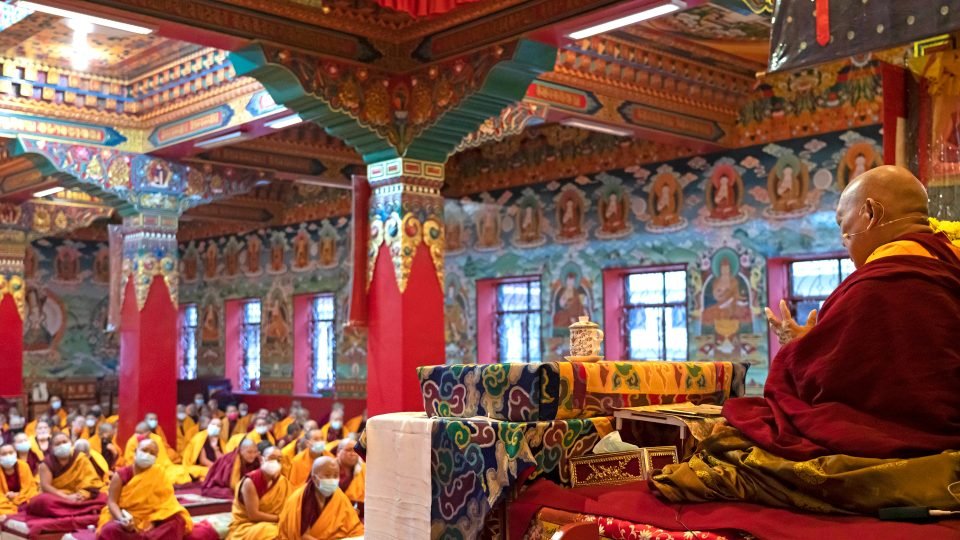
Lama Zopa Rinpoche teaching at Khachoe Ghakyil Nunnery, Kopan Monastery, Nepal, November 2021. Photo by Ven. Lobsang Sherab.
Since our last update, Lama Zopa Rinpoche has remained in Nepal, concluding his teachings at Kachoe Ghakyil Ling Nunnery, celebrating a birthday, visiting Pokhara and Patan for a variety of auspicious activities, and taking a pause from teachings. We invite you to rejoice in Rinpoche’s compassionate service to others and enjoy some new photos we have made available.
Kopan Monastery and Kachoe Ghakyil Ling Nunnery
Lama Zopa Rinpoche’s seventy-sixth birthday was celebrated on December 3 at Kopan Monastery. The festive day included the offering of a large Tara statue to Rinpoche during the early morning Sixteen Arhats long life puja. The statue was offered to Rinpoche on behalf of the entire FPMT organization. Also, a special lunch was prepared for all Kopan monks, nuns, and guests, which included presenting a birthday cake to Rinpoche, young monks singing “Happy Birthday,” and short plays. You can read more about these auspicious activities.

Lama Zopa Rinpoche during the Sixteen Arhats puja offered to him on his birthday, Kopan Monastery, Nepal, December 2021. Photo by Ven. Topgye.
Starting on December 10 and over the course of a few days Lama Zopa Rinpoche offered Yamantaka initiation at Kopan Monastery.
For nearly two months, Lama Zopa Rinpoche taught at Kachoe Ghakyil Ling Nunnery. The teachings ended right before the Christmas holiday on December 22. These teachings were translated into Nepali from Tibetan, providing a rare opportunity for Nepali people to have access to Rinpoche’s teachings in their own language and were made available on the FPMT Tibetan YouTube channel. Among many other topics, Rinpoche focused on how to distinguish between holy Dharma and worldly Dharma, and how to make sure all actions become holy Dharma.
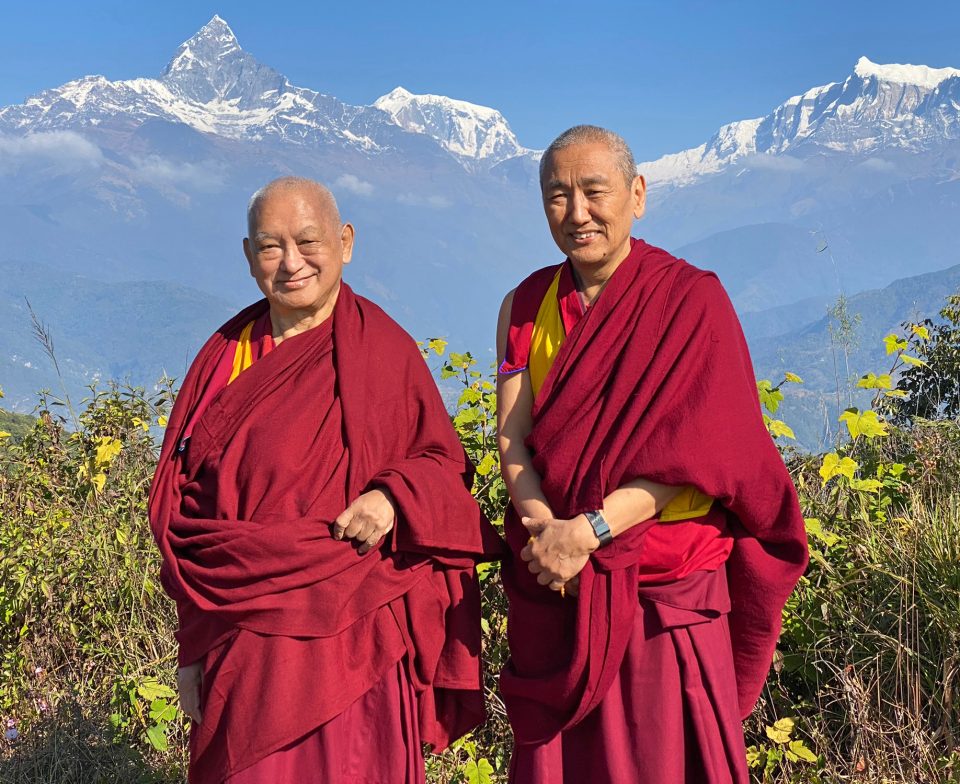
Lama Zopa Rinpoche and Khen Rinpoche Geshe Chonyi, the abbot of Kopan, Pokhara, Nepal, December 2021. Photo by Ven. Roger Kunsang.
Pokhara and the Ashoka Stupas in Patan
Following the conclusion of the teachings at the nunnery, Rinpoche traveled to Pokhara, which is Nepal’s second most populated city after Kathmandu. Located about 120 miles west and north of Kathmandu, Pokhara is a major tourist destination and is where the FPMT center Ganden Yiga Chözin Buddhist Meditation Centre is located. While there, Rinpoche used every moment to benefit others—offering Heruka incense puja, a teaching at the center, and blessing the fish and all beings in the lake.
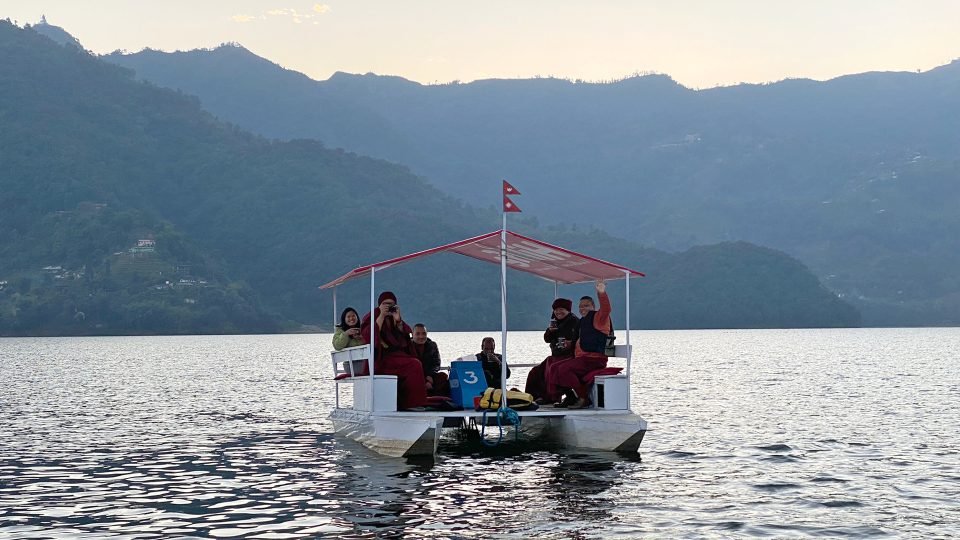
Rinpoche with Khen Rinpoche Geshe Chonyi, monks, and students blessing the sentient beings in the lake, Pokhara, Nepal. Photo by Ven. Roger Kunsang.
At the new year, Rinpoche traveled to Patan, which is now the third largest city in Nepal, located just south of Kathmandu. There Rinpoche and Rangjung Neljorma Khadro Namsel Drönme (Khadro-la) consecrated and offered prayers in front of three of what are known as the “Ashoka Stupas.” These ancient stupas are located around the historic city of Patan, where trade routes cross the city going towards India and Tibet. The western, southern, and eastern stupas are still in the form of grassy mounds although later additions were added by both Newari and Tibetan Buddhist. The northern stupa was renovated and plastered over half a century ago and looks more like Boudhanath Stupa. Nobody knows how old these stupas are or what is contained inside them because they have never been excavated. Legend tells us that either King Ashoka, or his daughter, or his emissaries came to the Kathmandu Valley and constructed them.
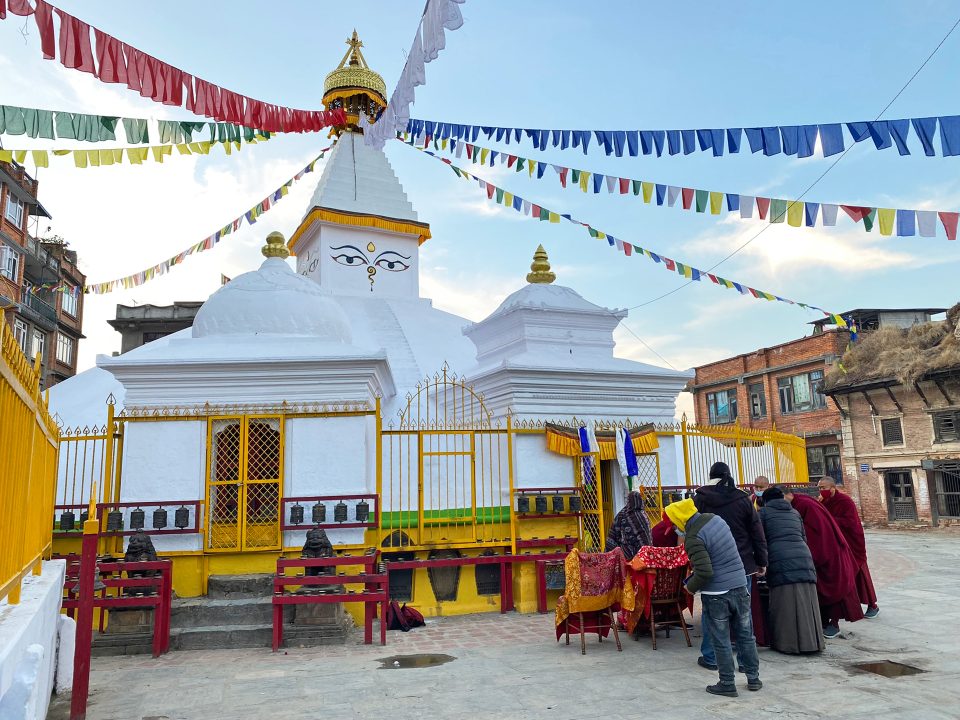
Ibahi Thur, the north Ashoka Stupa, where Rinpoche and Khadro-la offered prayers and did consecration, Patan, Nepal. Photo by Ven. Roger Kunsang.
King Ashoka was the warrior king, who famously converted to Buddhism and took the relics from seven of the original stupas constructed after the Buddha passed away, which he then distributed in stupas constructed throughout the Indian subcontinent. King Ashoka is said to have constructed or sponsored 84,000 stupas containing Buddha’s ashes. He visited Lumbini to worship at the birthplace of the Buddha in 249 BCE—a fact that was verified upon excavation of the site by the British, who uncovered an inscribed pillar recording the visit. If the Ashoka Stupas were constructed on the command of King Ashoka they are very old.
The northern stupa is called Ibahi Thur; the eastern stupa is Teta Thur; the southern stupa is Lagan Thur; and the western stupa is Pulchowk Thur. Although three were originally constructed outside the historical boundaries of Patan, the city has recently become so developed that they are now mostly on busy roads or surrounded by buildings. There is also a central stupa, the Pimbahal Stupa, which is quite different in style, since it was destroyed in 1350 CE during an attack by Muslim invaders from Bengal and subsequently restored.

Rinpoche and Khadro-la consecrating one of the Ashoka Stupas and offering prayers, Patan, Nepal. Photo by Ven. Roger Kunsang.

Rinpoche and Khadro-la consecrating one of the Ashoka Stupas and offering prayers, Patan, Nepal. Photo by Ven. Roger Kunsang.
Stay Connected and Please Rejoice!
Rinpoche will be taking a break from teachings, but we look forward to their continuation in the near future, and we will share new videos and summaries as they become available. Meanwhile, we will continue to offer excerpts from Rinpoche’s teachings of recent years.
Please rejoice in Rinpoche’s continued auspicious activities, benefiting others at every opportunity. We have created a new photo album of Rinpoche, including activities we didn’t mention above, which we invite you to enjoy.
Visit the November–December 2021 photo album:
https://fpmt.org/teachers/zopa/gallery/nepal-november-december-2021/
Lama Zopa Rinpoche is the spiritual director of the Foundation for the Preservation of Mahayana Tradition (FPMT), a Tibetan Buddhist organization dedicated to the transmission of the Mahayana Buddhist tradition and values worldwide through teaching, meditation and community service.
Thanks to Ven. Sarah Thresher for her research on the Ashoka Stupas.
- Tagged: ashoka stupas, holy objects, kopan monastery, lama zopa rinpoche, lama zopa rinpoche activities, nepal, patan, pokhara, stupas
14
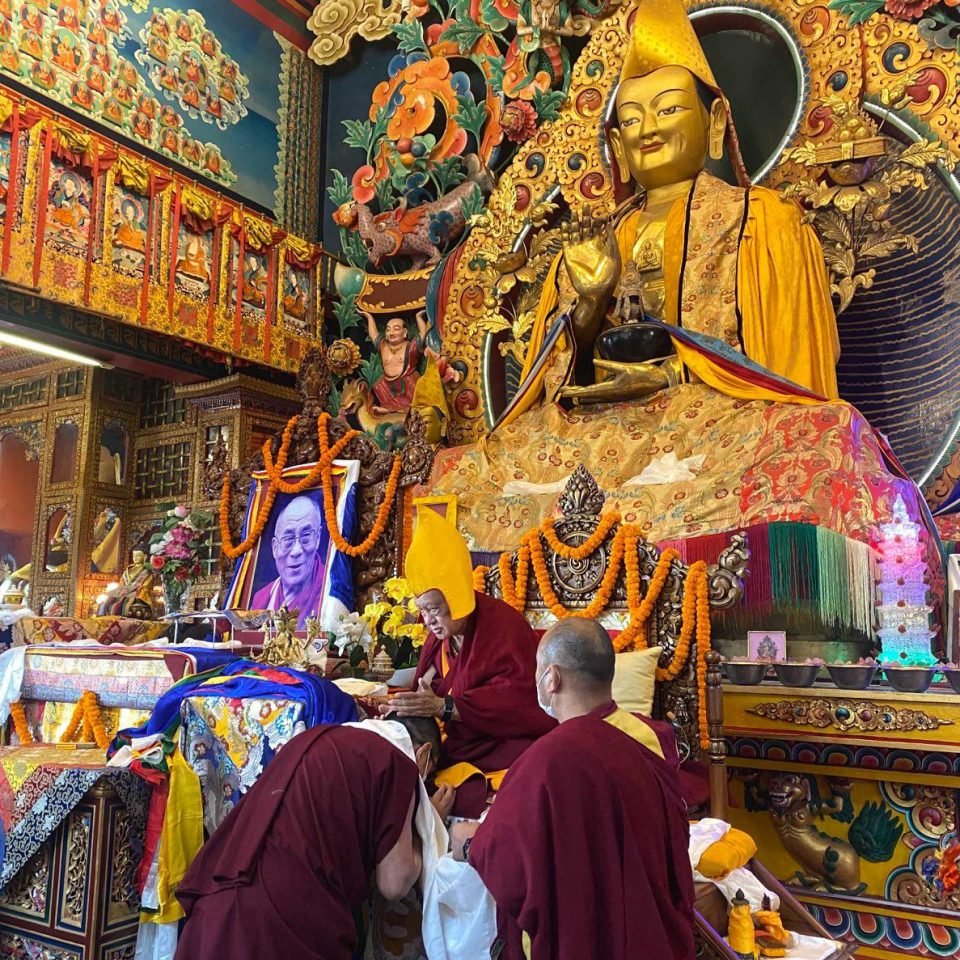
Lama Zopa Rinpoche during Sixteen Arhats long life puja offered to Rinpoche on his birthday, Kopan Monastery, Nepal, December 2021. Photo by Ven. Lhundrup Topgye.
The celebration of Lama Zopa Rinpoche’s birthday on December 3 began in the early morning with the offering of a Sixteen Arhats long life puja to Rinpoche in the main gompa at Kopan Monastery in Nepal.
During the offerings part of the puja, a group of monks carried in a beautiful large Tara statue. Ven. Roger Kunsang, Rinpoche’s assistant and CEO of FPMT Inc, offered the golden statue to Rinpoche on behalf of the entire FPMT organization. Rinpoche later offered the statue to Rangjung Neljorma Khadro Namsel Drönme (Khadro-la).
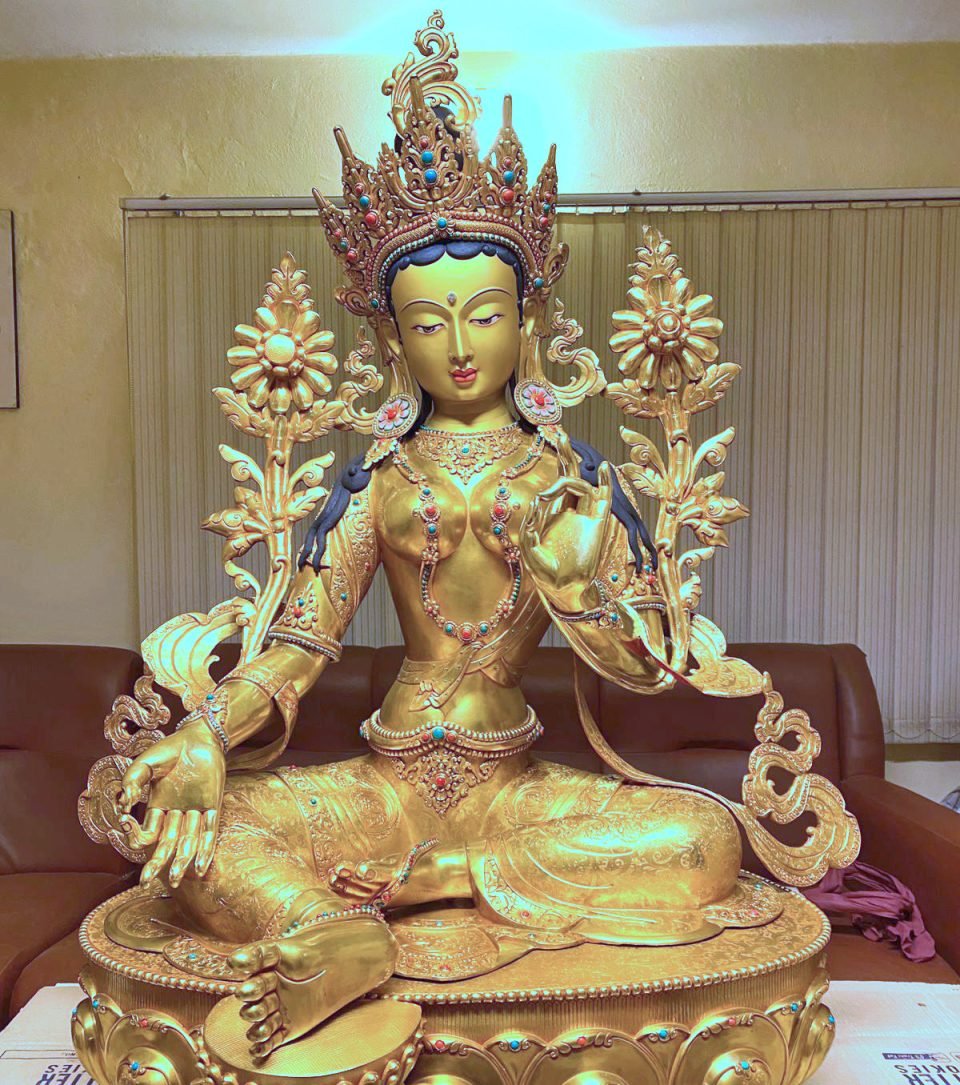
Tara statue offered to Lama Zopa Rinpoche during the Sixteen Arhats long life puja at Kopan Monastery
After the puja, a delicious buffet lunch with many dishes was prepared for all in the stupa garden at Kopan. Lama Zopa Rinpoche, Kopan monks and nuns, and guests sat among the stupas for Geshe Lama Konchog and Khensur Rinpoche Lama Lhundrup. A tent and table were set up for Rinpoche. Kopan Abbot Khen Rinpoche Geshe Chonyi was present for the events as well as Rinpoche’s brother Sangye and his family.
After lunch, Rinpoche was presented with a large tiered birthday cake. A group of young monks, including Rigsel Rinpoche, the reincarnation of Khensur Rinpoche Lama Lhundrup, sang “Happy Birthday” to Rinpoche while holding khatas. They also sang praises to different gurus.
Rinpoche turned the birthday cake into a tsog offering. He made a nice dedication to His Holiness the Dalai Lama. He then cut the first slice of cake.
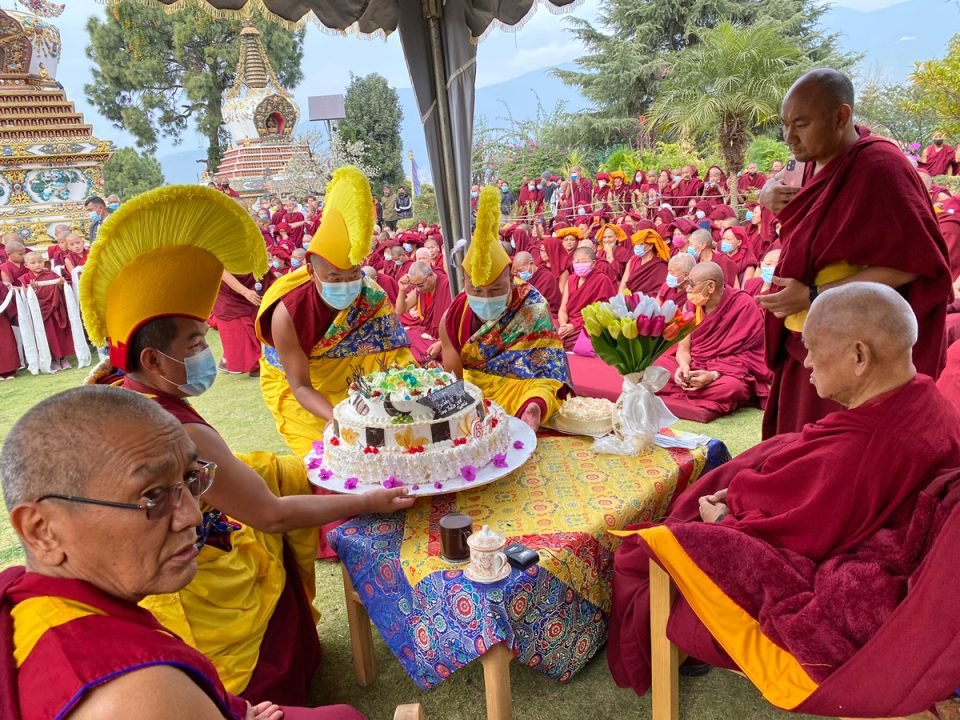
Offering cake to Lama Zopa Rinpoche on his birthday, Kopan Monastery, Nepal, December 3, 2021. Photo by Ven. Roger Kunsang.

Lama Zopa Rinpoche with the birthday cake offered to him, Kopan Monastery, Nepal, December 2021. Photo by Ven. Lhundrup Topgye.
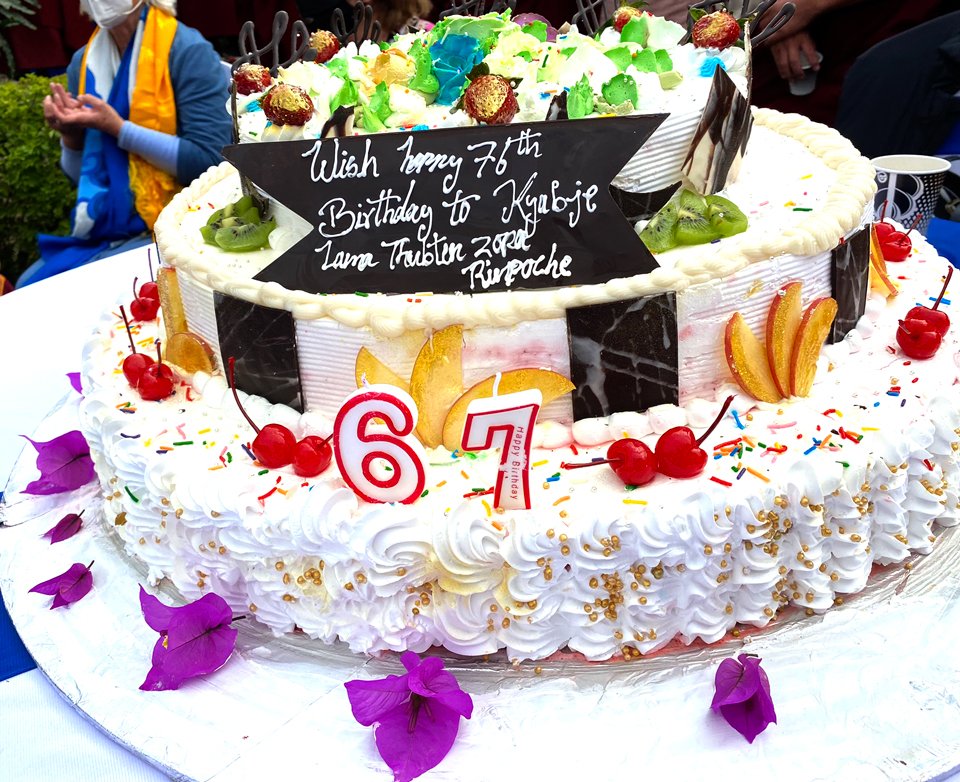
Birthday cake offered to Lama Zopa Rinpoche on his birthday, celebrated at Kopan Monastery, Nepal, December 3, 2021. Photo by Ven. Roger Kunsang.
Also during the afternoon, there was a musician playing dramyin, who accompanied the young monks singing. A group of monks, some dressed in costumes, including young monks dressed up as goats, performed a series of short plays for all gathered in the garden. The final play was a story from the life of Geshe Ben Gungyal. Afterwards, the performers offered khatas to Rinpoche.
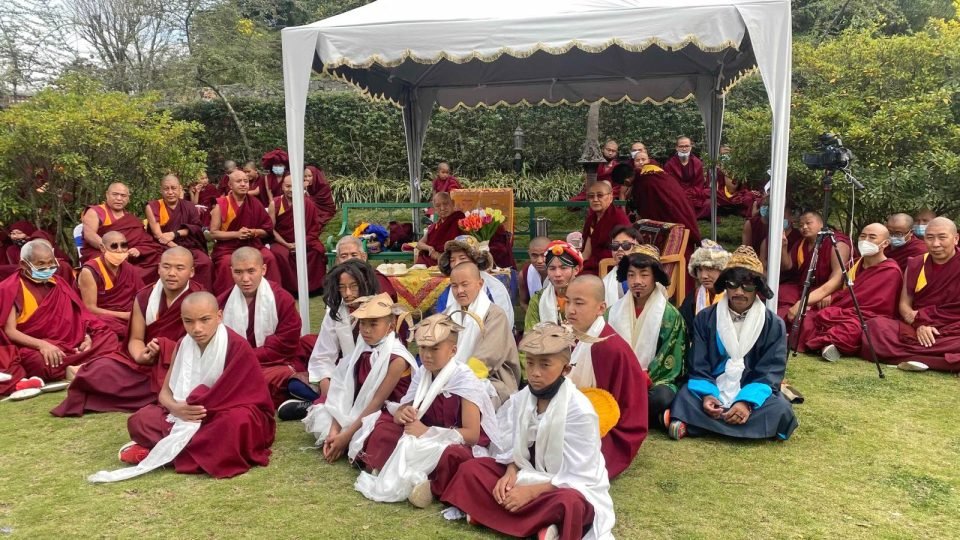
Monks who offered plays for Lama Zopa Rinpoche’s birthday celebration with Rinpoche at the close of the event, Kopan Monastery, Nepal, December 2021. Photo by Ven. Lhundrup Topgye.
Thanks to Ven. Roger Kunsang, CEO of FPMT Inc., and Frances Howland, FPMT South Asia Regional Coordinator, for details on the event. For more, you can find videos of the celebration of Lama Zopa Rinpoche’s birthday on the Facebook pages of Kopan Monastery and Kopan Monastery School.
You can watch videos from the ongoing series Lama Zopa Rinpoche’s Teachings on Thought Transformation, recorded at Kopan Monastery. Find links to transcripts, MP3s, additional practice advice, and more on the video series page on FPMT.org.
Lama Zopa Rinpoche is the spiritual director of the Foundation for the Preservation of Mahayana Tradition (FPMT), a Tibetan Buddhist organization dedicated to the transmission of the Mahayana Buddhist tradition and values worldwide through teaching, meditation and community service.
6
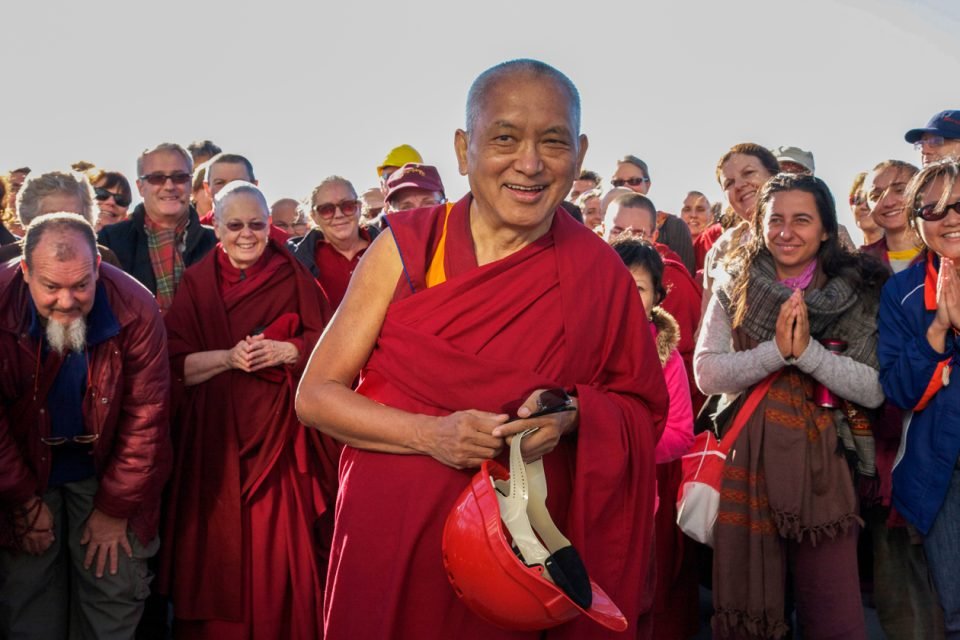
Lama Zopa Rinpoche at the Great Stupa of Universal Compassion, Bendigo, Australia, April 2011. Photo by Ven. Roger Kunsang.
In early April 2011, Lama Zopa Rinpoche began teaching a retreat series at the Great Stupa of Universal Compassion in Bendigo, Australia, focused on Shantideva’s Bodhicaryavatara (A Guide to the Bodhisattva’s Way of Life) and the transmission of the rare Rinjung Gyatsa initiations. Co-hosted by the Great Stupa, Atisha Centre, and Thubten Shedrup Ling Monastery, and attended by nearly 200 students, Rinpoche taught for about ten days before manifesting the symptoms of a stroke. Now for the first time, these precious teachings from Rinpoche have been made publicly available and can be streamed for free.
Rinpoche continued his teaching of Bodhicaryavatara and Rinjung Gyatsa retreat series at the Great Stupa in September-October 2014 and April-May 2018, and was scheduled to lead the March-April 2020 retreat, which was postponed due to the pandemic.
You can read more about the April 2011 retreat and Rinpoche manifesting a stroke in two articles from Mandala July-September 2011: “The Retreat of a Lifetime” and “When the Guru Manifests a Stroke.” You can also watch archival video footage from the retreat in the story “Remembering a Retreat of a Lifetime.”
Visit this page to find all the videos, transcripts, and audio files for Rinpoche’s Bendigo April 2011 teachings:
https://fpmt.org/media/streaming/teachings-of-lama-zopa-rinpoche/lama-zopa-rinpoche-teachings-in-bendigo-australia-2011

Lama Zopa Rinpoche offering a khata to Guru Rinpoche at the Great Stupa of Universal Compassion, Bendigo, Australia, April 2011. Photo by Ven. Thubten Kunsang.
Watch the current video series Lama Zopa Rinpoche’s Teachings on Thought Transformation on FPMT.org and find links to transcripts, MP3s, additional practice advice, and more.
Lama Zopa Rinpoche is the spiritual director of the Foundation for the Preservation of Mahayana Tradition (FPMT), a Tibetan Buddhist organization dedicated to the transmission of the Mahayana Buddhist tradition and values worldwide through teaching, meditation and community service.
- Tagged: australia, australia retreat 2011, bendigo, fpmt australia, great stupa of universal compassion, lama zopa rinpoche, video
2
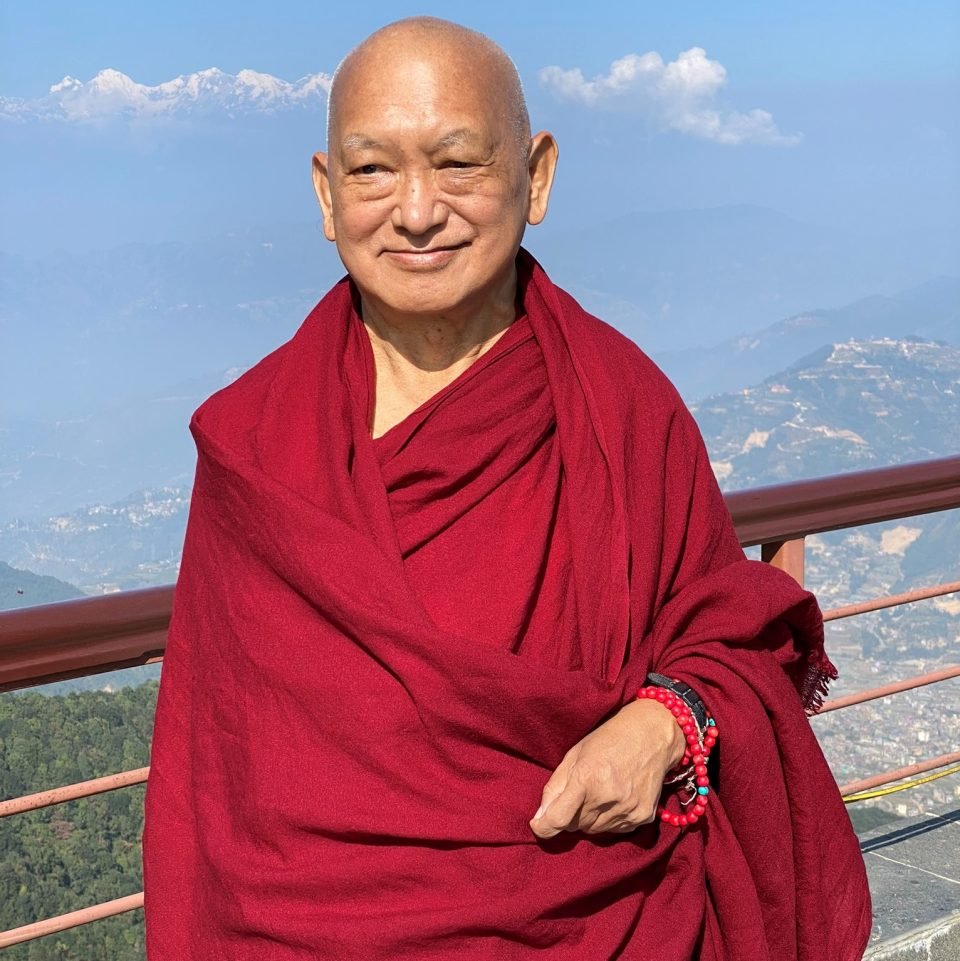
Lama Zopa Rinpoche, Nepal, November 2021. Photo by Ven. Roger Kunsang.
Lama Zopa Rinpoche’s birthday is celebrated on December 3. We invite you to join the entire FPMT community as we rejoice in another year of Rinpoche’s compassionate life. Rinpoche tirelessly models the bodhichitta motivation for us, benefiting countless others every single moment of every day.
A celebration for Rinpoche will begin at Kopan Monastery on the morning of December 3. We look forward to sharing all the joyous details of this celebration.
Through his recent activities and teachings, Rinpoche continues to guide us so that we make the most of this precious human rebirth by benefiting others and not causing harm. It is not enough to achieve liberation from samsara for oneself alone, Rinpoche regularly reminds us. We must aspire to liberate every single numberless sentient being from the oceans of samsaric suffering and bring them to enlightenment. Rinpoche is a living example of these teachings. And we can all find inspiration in how Rinpoche offers compassion to all living beings without a single one left out, including the most vulnerable, feared, harmful, and difficult among us.
Please join the entire FPMT community, including students and friends around the world, in offering sincere prayers for Lama Zopa Rinpoche’s long and healthy life. (All are welcome to download Long Life Prayers for Lama Zopa Rinpoche.) Rinpoche, please, please live long!
Lama Zopa Rinpoche is the spiritual director of the Foundation for the Preservation of Mahayana Tradition (FPMT), a Tibetan Buddhist organization dedicated to the transmission of the Mahayana Buddhist tradition and values worldwide through teaching, meditation, and community service.
Watch Lama Zopa Ripoche’s current video series on thought transformation and find links to videos in transcripts, MP3s, additional practice advice, and more:
https://fpmt.org/fpmt/announcements/resources-for-coronavirus-pandemic/advice-from-lama-zopa-rinpoche-for-coronavirus/
16

Rinpoche giving teachings at Khachoe Ghakyil Ling, Nepal, October 2021. Photo by Ven. Lobsang Sherab.
Since our last update, Lama Zopa Rinpoche has remained in Nepal and has been offering two ongoing teaching events. Rinpoche also celebrated Lhabab Duchen, gave advice via video at the fortieth anniversaries of two FPMT centers, and engaged in many other beneficial activities. We invite you to enjoy some of the details of Rinpoche’s compassionate service to others!
Rinpoche Offers Teachings
Rinpoche continued his video thought transformation teachings during this time, offering teachings for ordained Sangha and also extensive teachings on Buddhist refuge. In Rinpoche’s refuge teachings he warns that we must be careful about the objects in which we take refuge. For example, people take refuge in animals, nature, or spirits, but none of these have the qualities of the Buddha or can offer us ultimate refuge—freedom from samsara. Rinpoche also discussed depression, explaining that to understand the mental states of others we first have to understand our own craziness. Then, when we think of others, we will be able to more easily develop compassion.

Lama Zopa Rinpoche teaching at Khachoe Ghakyil Ling, Nepal. Photo by Ven. Sarah Thresher.
Rinpoche has been offering regular teachings at Khachoe Ghakyil Ling, also known as the Kopan Nunnery, for the past three weeks. These teachings are being translated into Nepali from Tibetan, providing a rare opportunity for Nepali people to have access to Rinpoche’s teachings in their own language. These teachings are available on the FPMT Tibetan YouTube channel. Half in attendance at the teachings are nuns and half are people from outside the nunnery. Topics taught include what is and is not holy Dharma, the eight worldly dharmas, the preciousness of this human rebirth, karma, proper motivation, the importance of a good heart, and the kindness of the enemy. Rinpoche offered a White Tara jenang and the oral transmission of the Vajra Cutter Sutra. The teaching series will end with a Medicine Buddha initiation.
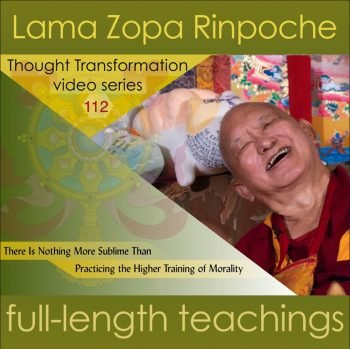
A recent podcast episode.
“Of all practices, the practice of kindness is best,” Rinpoche emphasized during these teachings. “Of all forms of education, the best education is how to be a kind person. Parents should teach their children to have a kind heart from a young age. That will help them the most when they grow up. It will help their friends, their neighborhood, their town, their country, the world.”
A new podcast series featuring full-length teachings by Lama Zopa Rinpoche was recently launched. Each episode corresponds to a new video in the ongoing series of Rinpoche’s thought transformation teachings. Episodes are released shortly after the latest video teaching and blog are published, so listeners have access to the transcript and other materials associated with a specific teaching. For the podcast episodes, pauses have been shortened and background noise reduced, but otherwise the teachings are unedited. Currently we have podcast episodes for Rinpoche’s video teachings from July 2021 onward (videos 102–123).

Lama Zopa Rinpoche walking to offer puja on the land in Maratika where the giant Padmasambhava statue will be built, Nepal, September 2021. Photo by Ven. Lobsang Sherab.
Rinpoche Travels to Maratika
In September 2021, Rinpoche returned to Maratika along with Kopan lama gyupas monks and nuns to bless the land where a 45-foot (14-meter) tall statue of Padmasambhava (Guru Rinpoche) on a 15-foot (4.5-meter) tall throne will be built. The statue will be in the aspect of Padma Gyalpo, Padmasambhava’s magnetizing form, and will be made of bronze and plated with gold. It is expected to take around five years to complete. During this visit, Rinpoche spent time meeting with some local people, including the mayor of Maratika. He offered teachings to two hotel owners. He also blessed the goats in Maratika liberated for his long life, gave two online Zoom teachings, and visited the main cave, which was opened only for Rinpoche, to make special prayers at the long life vase.
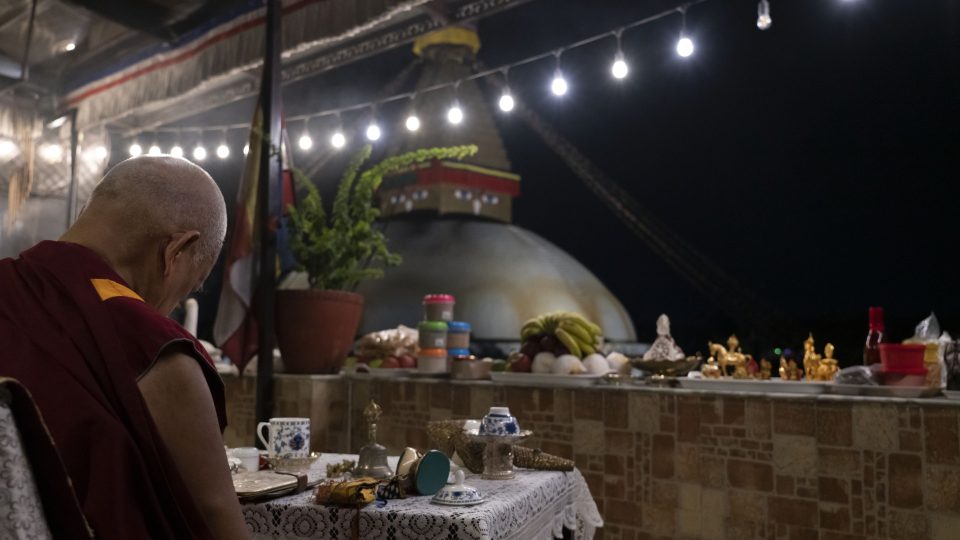
Lama Zopa Rinpoche offering puja in front of Boudhanath Stupa, Nepal, October 15, 2021. Photo by Ven. Lobsang Sherab.
Rinpoche Circumambulates and Makes Offerings to Stupas
While Rinpoche is in Nepal, he frequently goes to visit the great stupas of Boudhanath and Swayambhunath to circumambulate and make offerings and prayers. Sometimes Rinpoche goes in the evenings, sometimes after teachings, sometimes on the way back from trips in Kathmandu or other places.
When Rinpoche goes to Boudha Stupa he usually does korwa while reciting the mantras that increase the power of making circumambulation. Students in attendance join in as Rinpoche recites out loud In Praise of Dependent Origination by Lama Tsongkhapa, followed by several repetitions of the Confession of Downfalls to the Thirty-five Buddhas and Vajrasattva mantra to purify. At the end of the circumambulations, Rinpoche leads a group offering of five-colored khatas to the stupa and dedication prayers. During the circumabulations, Rinpoche also likes to offer incense and rice visualized as wish-granting jewels, bless the dogs, and turn the prayer wheels.
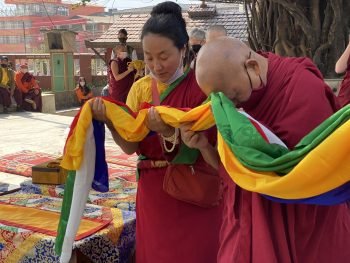
Lama Zopa Rinpocha and Khadro-la offering five-colored khata at Swayambhunath Stupa on Lhabab Duchen. Photo by Ven. Roger Kunsang.
When Rinpoche goes to Swayambhunath, he circumambulates around the base of the hill. As Rinpoche circumambulates, he recites prayers, offers rice visualized as wish-granting jewels, and rejoices for all those who helped construct the many prayer wheels and stupas that encircle the hill. Rinpoche stops at a special Padmasambhava statue to chant prayers and pray for His Holiness the Dalai Lama and Tibet. Rinpoche also stops at the local cremation grounds to recite prayers for those who have recently died and whose corpses are being burned.
On Lhabab Duchen Rinpoche offered pujas, prayers, and five-colored khatas with Khadro-la (Rangjung Neljorma Khandro Namsel Drönme) at Swayambunath. You can read more about the activities sponsored during this merit-multiplying Buddha day.
Winter Debates at Kopan
Monks have held the Jang Guncho, the winter debate festival, for centuries. The first Nuns’ Jang Guncho took place in Dharamsala, India, in 1995. Jang Guncho is an opportunity for ordained Sangha to gather together to train in and practice debate. Lama Zopa Rinpoche attended the winter debates of both Kopan Monastery and Khachoe Ghakyil Ling early this October.

Lama Zopa Rinpoche attending the winter debate of the nuns of Khachoe Ghakyil Nunnery, Nepal, October 11, 2021. Photo by Ven. Lobsang Sherab.
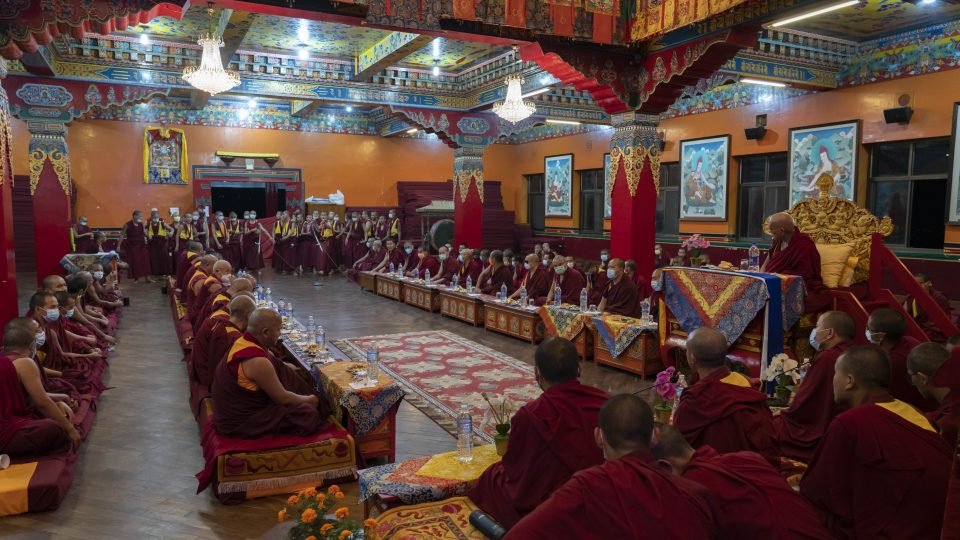
Lama Zopa Rinpoche attending the winter debate of the monks of Kopan Monastery, Nepal, October 8, 2021. Photo by Ven. Lobsang Sherab.
Rinpoche Offers Encouragement and Advice during the Fortieth Anniversary Celebrations of Two FPMT Centers
Nalanda Monastery, the FPMT monastery in the south of France, has been celebrating its fortieth anniversary this year. In October, Rinpoche offered the Nalanda community an encouraging and joyful talk from Kopan Monastery, urging everyone to meditate strongly on impermanence and death in order to change worldly dharma into holy Dharma. Rinpoche also praised those who are Sangha in the West, explaining that they are the “real heroes” due to the “incredible renunciation” of becoming ordained.
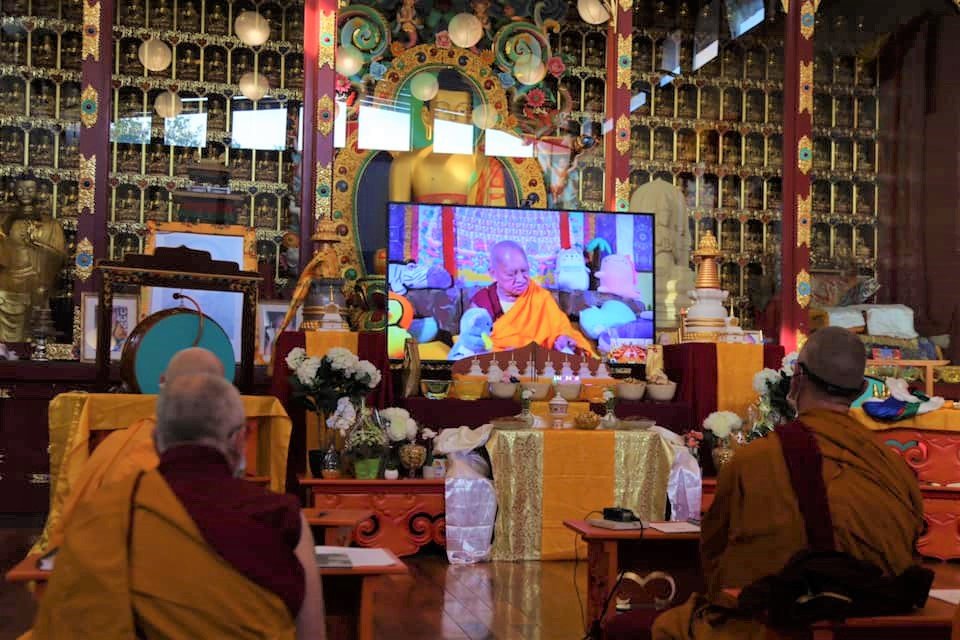
Lama Zopa Rinpoche offering a talk to the Nalanda Monastery community, France, October 18, 2021. Photo courtesy of Nalanda Monastery’s Facebook page.
Buddha House, an FPMT center located in a suburb of Adelaide, South Australia, also celebrated its fortieth anniversary this year. In October, Rinpoche offered a teaching via video on the importance of FPMT centers and on emptiness. “You can see how it is most important for the center to exist!” Rinpoche said. “[Centers share] Lama Tsongkhapa teachings, Buddha’s teachings. [Centers create] an opportunity for sentient beings to study, to learn with no mistakes! Thank you very much!” We look forward to sharing video of this teaching with you and a summary of the main points Rinpoche expressed. (Extensive advice from Rinpoche is always available on the benefits of offering service as well as on the benefits of centers and the FPMT Organization. See Rinpoche’s Advice page.)
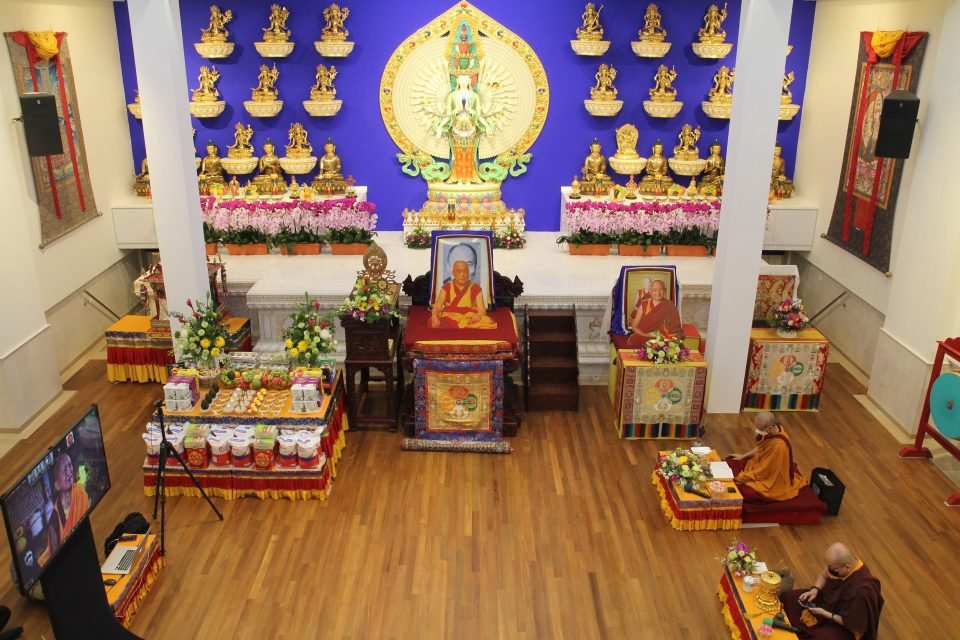
Thousand-Arm Chenrezig statue and Twenty-one Tara statues at Amitabha Buddha Centre with image of Lama Zopa Rinpoche offering a talk via video, Singapore. Photo courtesy of ABC.
Twenty-one Tara Statues Consecration at Amitabha Buddhist Centre
In 1995, Lama Zopa Rinpoche advised Amitabha Buddhist Centre (ABC) in Singapore to buy land and build on it a dedicated temple that has as its central image Thousand-arm Chenrezig surrounded by the Twenty-one Taras. The land was bought in 1998. Construction began in 2003. And in 2007, the center opened its doors. The Thousand-arm Chenrezig statue was completed in 2016. And this year, the Twenty-one Tara statues were completed and consecrated on October 27.
ABC organized a celebratory event for the consecration, which was broadcast live over several online platforms with translations offered in seven languages. Lama Zopa Rinpoche did the consecration of the statues via Zoom from Kopan Monastery. He also gave a teaching and made strong prayers for the statues to be of great benefit to sentient beings. Nine hundred people joined via Zoom with a thousand others joining on Facebook Live. Center Director Tan Hup Cheng offered an opening speech for the event. There was a short video of how the statues were made in Nepal and installed on the altar. Khenrinpoche Geshe Chonyi, ABC’s resident teacher, unveiled the statues. Ven. Sangye Khadro and Ven. Thubten Chodron shared congratulatory messages via video, including a moving prayer to Tara, which had been translated by Lama Yeshe from the Cittamani Tara long sadhana. The program ended with extensive dedications. We are pleased to share video of this auspicious event. A complete transcript of this teaching, as well as more photos and details of the event will be shared in the near future.
Please Enjoy New Photos of Rinpoche’s Recent Activities
Please join us in rejoicing in all of Rinpoche’s beneficial activities for others! We have created a new photo album of Rinpoche, including many activities we didn’t mention above, which we invite you to enjoy.
Visit the September–October 2021 photo album:
https://fpmt.org/teachers/zopa/gallery/nepal-september-october-2021/
Lama Zopa Rinpoche is the spiritual director of the Foundation for the Preservation of Mahayana Tradition (FPMT), a Tibetan Buddhist organization dedicated to the transmission of the Mahayana Buddhist tradition and values worldwide through teaching, meditation and community service.
Watch the video series Lama Zopa Rinpoche’s Teachings on Thought Transformation during the Time of COVID-19 and find links to videos in transcripts, MP3s, additional practice advice, and more:
https://fpmt.org/fpmt/announcements/resources-for-coronavirus-pandemic/advice-from-lama-zopa-rinpoche-for-coronavirus/
- Home
- News/Media
- Study & Practice
- About FPMT Education Services
- Latest News
- Programs
- New to Buddhism?
- Buddhist Mind Science: Activating Your Potential
- Heart Advice for Death and Dying
- Discovering Buddhism
- Living in the Path
- Exploring Buddhism
- FPMT Basic Program
- FPMT Masters Program
- FPMT In-Depth Meditation Training
- Maitripa College
- Lotsawa Rinchen Zangpo Translator Program
- Universal Education for Compassion & Wisdom
- Online Learning Center
- Prayers & Practice Materials
- Overview of Prayers & Practices
- Full Catalogue of Prayers & Practice Materials
- Explore Popular Topics
- Benefiting Animals
- Chenrezig Resources
- Death & Dying Resources
- Lama Chopa (Guru Puja)
- Lama Zopa Rinpoche: Compendium of Precious Instructions
- Lama Zopa Rinpoche: Life Practice Advice
- Lama Zopa Rinpoche Practice Series
- Lamrim Resources
- Mantras
- Prayer Book Updates
- Purification Practices
- Sutras
- Thought Transformation (Lojong)
- Audio Materials
- Dharma Dates – Tibetan Calendar
- Translation Services
- Publishing Services
- Teachings and Advice
- Find Teachings and Advice
- Lama Zopa Rinpoche Advice Page
- Lama Zopa Rinpoche: Compendium of Precious Instructions
- Lama Zopa Rinpoche Video Teachings
- ༧སྐྱབས་རྗེ་བཟོད་པ་རིན་པོ་ཆེ་མཆོག་ནས་སྩལ་བའི་བཀའ་སློབ་བརྙན་འཕྲིན།
- Podcasts
- Lama Yeshe Wisdom Archive
- Buddhism FAQ
- Dharma for Young People
- Resources on Holy Objects
- Ways to Offer Support
- Centers
- Affiliates Area
- Teachers
- Projects
- Charitable Projects
- Make a Donation
- Applying for Grants
- News about Projects
- Other Projects within FPMT
- Support International Office
- Projects Photo Galleries
- Give Where Most Needed
- FPMT
- Shop
Translate*
*powered by Google TranslateTranslation of pages on fpmt.org is performed by Google Translate, a third party service which FPMT has no control over. The service provides automated computer translations that are only an approximation of the websites' original content. The translations should not be considered exact and only used as a rough guide.When Lord Buddha spoke about suffering, he wasn’t referring simply to superficial problems like illness and injury, but to the fact that the dissatisfied nature of the mind itself is suffering.
